
- Top Attractions

Puerta del Sol
Puerta del Sol (meaning The Sun's Gate in English) is one of the most renowned central squares in Madrid, a meeting point both for tourists and Madrileños, and home to several of the city’s landmarks, such as the Kilometre zero.
The plaza was built in different stages. During the fifteenth century, La Puerta del Sol was originally one of the gates of the city wall and three centuries later, mid-eighteenth century, the Casa de Correos was established, today the headquarters of the Presidencia de la Comunidad.
Finally, between 1857 and 1862, the architects Lucio del Valle, Juan Rivera and José Morer gave it its definitive form. During the twentieth century, the fountain was placed in the centre of the square and part of it was pedestrianised.
Points of interest
The Puerta del Sol houses three well-known symbols of Madrid:
- El Oso y el Madroño (Statue of the Bear and Strawberry Tree) : At the entrance of Calle Alcalá is a sculpture of a bear and strawberry tree, representing the coat of arms of Madrid. It was built in 1967 and is a popular meeting point for locals and tourists in Sol.
- Real Casa de Correos (House of the Post Office): The Real Casa de Correos contains the famous clock that, since 1962, has marked the eating of the twelve grapes (a Spanish new year tradition whereby a grape is eaten with each chime of the clock) on new years’ eve.
- Kilometre Zero (KM 0): The Kilometre 0 is located on the pavement in front of the Real Casa de Correos. It marks the point from which the distances in Madrid are measured.
Several important historical events have taken place in Puerta del Sol such as the proclamation of the Second Republic in 1931 and recently, in 2011, the 15-M Movement , a vast demonstration for Spanish democracy.
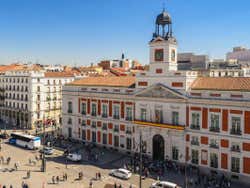
Two Days in Madrid
City center
Metro : Sol , lines 1, 2 and 3. Cercanías : C3 and C4. Bus : lines 3 and 51.
Nearby places
Plaza Mayor in Madrid (350 m) Plaza de Santa Ana (350 m) Plaza del Callao (366 m) Gran Vía, Madrid (416 m) Mercado de San Miguel (464 m)
You may also be interested in
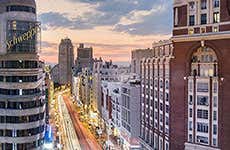
Built between 1910 and 1929, Gran Vía is Madrid’s most famous street, connecting Salamanca and Argüelles and full of shops, restaurants and some of the capital's most iconic buildings.
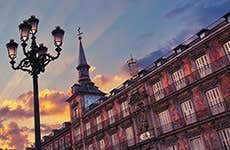
Plaza Mayor
The Plaza Mayor (meaning Main Square in English) is located in the heart of Madrid, near Puerta del Sol and the Royal Palace.


Exploring Puerta del Sol – The Heart of Madrid
Puerta del Sol is often referred to as the heart of Madrid. It’s a bustling square that has become one of the most popular meeting points for locals and tourists. If you’re looking to explore some of Madrid’s top attractions, this place should be on your list.
With its rich history and vibrant atmosphere, there’s always something new to discover at Puerta del Sol. In this article, we’ll take a closer look at what makes this square unique and some of the must-see sights you can find here. From street performers to world-famous landmarks, there’s something for everyone at Puerta del Sol. So let’s jump right in!
History of Puerta del Sol
Puerta del Sol, the bustling heart of Madrid, has a rich and fascinating history. Dating back to the 15th century when it was one of the city’s gates, this iconic plaza has witnessed numerous important events throughout Spain’s history. Puerta del Sol has always been a hub of activity and is now regarded as one of Europe’s busiest public spaces, from political demonstrations to royal proclamations and even bullfights. Let us delve deeper into the intriguing past of one of Madrid’s most popular attractions.
Origins of Puerta del Sol
Puerta del Sol, which means Gateway of the Sun in Spanish, is a famous public square at the heart of Madrid, Spain. Its name comes from the eastern city gate during the 15th century. This gate had a sun emblem on it and served as a symbol of welcome to visitors coming to Madrid via the direction of the nearby city of Alcala.
During the Habsburg period in Madrid’s history, Puerta del Sol became a central point for city life. After the royal palace was relocated to another area in Madrid, Puerta del Sol became its new center. The square was expanded, buildings were constructed around it, and important streets, such as Calle Mayor, were built leading towards it. A former prison known as Casa de la Carnicería also stood near Puerta del Sol at that time.
In the 17th and 18th centuries, Puerta del Sol took on historical significance as a site where many important events occurred. In 1623, King Philip IV inaugurated “La Mariblanca,” a white marble statue depicting Venus that still stands in front of one of the buildings surrounding the square. Additionally, this square marks where an uprising against French occupation began in May 1808.
Puerta del Sol during the 19th and 20th centuries
Amidst a century of social and economic turmoil, Madrid’s oldest and most lively square underwent critical changes in its layout for the first time since its origination. During the 19th century, significant renovations occurred at the Puerta del Sol, breathing new life into this historically significant landmark. The demolition of several adjacent buildings facilitated the expansion of the square to create space for a bigger traffic flow.
Puerta del Sol played a pivotal role during the Spanish Civil War; symbolic celebrations and battles ensued, making this square witness to historical accomplishments like no other place in Spain. It became an important meeting point between soldiers’ factions, despite being subject to heavy bombing raids that destroyed a significant portion of surrounding buildings.
The post-Civil War years in Spain were characterized by tremendous political change as General Francisco Franco maintained control over his regime’s affairs. From 1939 until Franco died in 1975, the famous clock tower in Sol displayed images glorifying Francoist ideology until an artistic piece from disaffected Spaniards replaced it.
During the second half of the twentieth century, Puerta del Sol established itself as a thriving hub for political activism and cultural happenings. This iconic destination remained central to those protesting against labor or economic regulations imposed by authorities in public spaces representing democracy- such demonstrations have continued throughout Europe since then.
After centuries of Catalan-speaking inhabitants clashing with Arabs occupying this important district during medieval times through wartime destructions orchestrated under Francoism to become a platform for activism movements focused on issues such as affordable housing. Puerta del Sol has come full circle, covering every major event emphasizing social change within Spain’s history books. Today it attracts thousands during New Year’s Eve celebrations, with millions following live broadcasts on TV channels worldwide that use this venue as a celebration of celebration amongst people – young or old, regardless of their backgrounds – coming together to embrace life’s vibrant moments!
Famous people associated with Puerta del Sol
One of the most notable is King Carlos III, who commissioned the construction of the iconic clock tower that still stands today.
Another famous figure linked to Puerta del Sol is Miguel de Cervantes, widely regarded as one of the greatest writers in Spanish literature. It is believed that he lived near the square for part of his life and used it as a setting in his works.
Other notable figures associated with Puerta del Sol include José Bonaparte, who installed himself as king of Spain with French backing in 1808 and erected a statue in his honor in the square. The statue was later replaced by one depicting King Carlos III.
In addition to famous individuals associated with Puerta del Sol, many celebrities have visited or stayed nearby while visiting Madrid. These include Salvador Dalí, Ernest Hemingway, Antonio Banderas, and Penélope Cruz.
Landmarks in Puerta del Sol
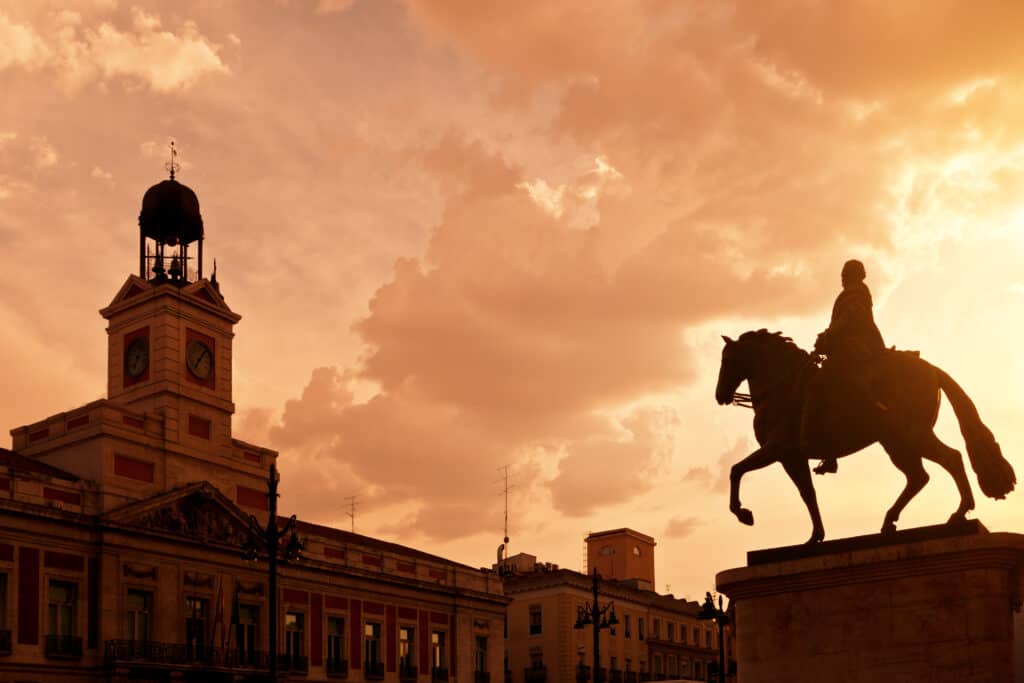
Landmarks in Puerta del Sol are not only symbols of architectural significance, but they also hold historical and cultural importance. From the iconic statue of the Bear and the Strawberry Tree to the clock tower of the Real Casa de Correos, each landmark serves as a testament to the rich heritage and legacy of the Spanish capital. Whether you’re strolling through Puerta del Sol for leisure or educational purposes, these landmarks will undoubtedly catch your eye and leave a lasting impression on your memory.
Clock Tower
In the center of Puerta del Sol stands the famous Clock Tower. The Clock Tower in Puerta del Sol symbolizes the cultural heritage and significance for Spain, representing the country’s history and people’s culture.
The Clock Tower was built between 1866 and 1868 by José Rodríguez de Losada. It comprises four clock faces and a bell that rings at midnight on New Year’s Eve to signal the start of a new year. The tower is also known as “Reloj de la Casa de Correos,” which translates to “Clock of the Post Office.”
The Clock Tower has witnessed significant moments in Spanish history, such as during the Civil War, where it served as a sniper position. The Tower has also played an important role in popular culture, serving as a setting for countless films and television series since the early 20th century.
Today, the Clock Tower continues to be an essential part of Spain’s cultural landscape. Visitors from all over the world come to see this beautiful landmark while exploring Madrid.
Statue of the Bear and the Strawberry Tree
Puerta del Sol is home to one of the city’s most iconic landmarks – the statue of the bear and the strawberry tree. This magnificent bronze statue depicts a bear reaching up to pick fruit from a madroño (strawberry) tree. But what is the symbolism behind this cherished work of art? Let’s explore.
The bear and the madroño tree have long been emblems of Madrid. The presence of these symbols dates back to medieval times when they appeared on the city’s crest. It is said that during hunting trips, Spanish monarchs often encountered bears attracted to madroño trees for their sweet and juicy berries.
The statue itself was commissioned in 1967 by Carlos III as part of an initiative to adorn Madrid with more public art. It was designed by artist Antonio Navarro Santafé, with sculptor José Luis Fernández responsible for its construction.
The bear represents strength and tenacity and has become synonymous with Madrid. Meanwhile, the madroño symbolizes hospitality and social gathering. To those who call Madrid home, it reminds them of their rich cultural identity.
But there may be another layer to this symbolism – some have suggested that both elements were chosen as a nod to Madrid being a city forever struggling against nature’s forces but always persevering due to its people’s strength.
The statue is an important cultural landmark for Madrileños and visitors alike. It encapsulates the history and contemporary identity in one emblematic artwork in arguably one of Spain’s most visited areas all year round – Puerta del Sol.
Post Office Building
The Post Office building in the bustling Puerta del Sol square is an architectural marvel steeped in history. The building’s construction dates back to 1768, when King Carlos III ordered the construction of a centralized postal system. Built-in neoclassical style, it is now an iconic symbol of Madrid that has seen many significant events over the years.
The location played a crucial role during Spain’s civil war as it was controlled by Franco’s troops, who used the clock tower to bombard enemy lines. After the war, the building became a symbol of Francoism and the dictatorship that lasted until 1975.
After democracy was restored, the government converted it into a cultural center, hosting exhibitions and concerts. Nowadays, its ground floor houses one of Madrid’s main tourist offices and several shops that offer stamps and souvenirs for collectors.
Aside from its historical significance, this iconic post office building also serves as a meeting point for Madrilenos and visitors alike. It’s common to see locals gather here for celebrations such as New Year’s Eve or to ring on any occasion. The building’s clock tower is brightly lit at night, adding charm and serving as an essential landmark for those navigating through Madrid.
In addition to being culturally significant, this beautiful edifice continues to serve its original purpose today- providing essential postal services to countless people from all around Spain and beyond daily. Those looking to mail postcards or letters while taking in some Spanish history should not miss out on visiting this impressive structure.
Kilometer Zero
At the center of the square lies Kilometer Zero, also known as “Kilómetro Cero” in Spanish. Kilometer Zero is a plaque embedded in the pavement that marks the point from which all major roads in Spain are measured.
The origin of Kilometer Zero dates back to the 18th Century. It was used by Spanish geographer Dionisio Alcalá Galiano to measure distances between cities in Spain. Over time, it became an important marker for transportation and navigation.
In addition to its practical use, Kilometer Zero has become a popular tourist attraction over the years. The location is marked with a unique symbol and is often surrounded by crowds of locals and tourists taking photos or admiring its significance.
Things to Do in Puerta del Sol
Puerta del Sol is one of Madrid’s busiest and most popular places. It is a public square that offers a wide range of activities to cater to everyone’s interests, from shopping, dining, people-watching, and entertainment shows.
For shopaholics, Puerta del Sol offers a vast array of shops selling everything from designer clothes and shoes to souvenirs. Visitors can find local brands and international designers here, with various stores, lined up on either side of the square for window shopping or directly shopping.
If you want to try out traditional Spanish cuisine, Puerta del Sol boasts several restaurants serving delicious traditional dishes like paella, tapas, or cocido (a hearty stew). Its lively atmosphere will offer visitors flavorful food and unforgettable dining experiences.
For visitors that prefer something more relaxed yet entertaining simultaneously – people watching may be what they need! Shaded seating areas within the plaza’s center make it easy to observe locals and tourists passing by or enjoying street performances.
Throughout the year, Puerta del Sol hosts several events celebrating cultural diversity that further bolsters much local enthusiasm. During the Christmas season, it features Spain’s famous tradition, “New Year’s Eve Countdown Party” making an otherwise busy square even more livelier and crowded during late nights, creating memories that tourists cherish for eternity!
Things to see near Puerta del Sol
One of the must-see attractions near Puerta del Sol is the Plaza Mayor . This beautifully designed square features stunning architecture, elegant arcades, and unique sculptures. It’s also home to many great restaurants where you can enjoy a delicious meal while still taking in the sights and sounds of this popular spot.
Another popular spot in the area is Gran Vía, Madrid’s most famous shopping street. Here you’ll find an array of high-end boutiques, department stores, and shoe shops. The street is also lined with cinemas and theaters that offer everything from blockbusters to indie films.
If you’re looking for some history while exploring Puerta del Sol, visit the Royal Palace of Madrid. This impressive building boasts over 3,000 rooms filled with beautiful artwork and historical artifacts. You can explore independently or hire a tour guide who will provide fascinating insights into the palace’s rich history.
A short walk away from Puerta del Sol is El Retiro Park . This expansive green space features beautiful gardens, ornate fountains, and a lake where visitors can rent boats or paddle on swan-shaped vessels. In addition to being a great place to relax, El Retiro Park hosts concerts and other cultural events throughout the year.
For those interested in art, head towards Museo Nacional Del Prado, one of Europe’s finest collections of European art dating from the 1300s-1900s featuring works by artists such as Francisco de Goya, Diego Velázquez, etc… It provides an enriching experience through its diverse collections.
In conclusion, Puerta del Sol offers many activities that cater to various tastes crammed within walking distance, suitable for travelers looking for fun-packed itineraries inclusive of sightseeing, relaxation, or both.
Nightlife in Puerta del Sol
Puerta del Sol is a famous landmark in the heart of Madrid, which hosts vibrant nightlife scenes. As it is known as the “Gateway to the Sun,” its nightlife carries on and lasts until dawn. The area around Plaza Mayor and Calle de las Huertas are favorite places for locals and tourists alike.
Walking along the narrow streets, you will stumble upon different types of bars, such as Vermuterias (specializing in vermouth), microbreweries, cocktail bars, clubs, and traditional taverns offering tapas and drinks. Some places even offer free tapas with your drink orders!
It’s also worth checking out an authentic Madrid flamenco show at Corral de la Moreria . You can also enjoy live music performances that go on until the late hours of the night.
For those who prefer a more laid-back atmosphere, head towards Plaza Santa Ana, where popular terrace bars overlook the plaza’s colorful buildings. These cozy corners often feature sofas to relax while drinking your cocktail or beer.
The district offers various venues catering to every taste or preference, with diverse music genres ranging from electronic, rock, and jazz. Moreover, Puerta del Sol is home to multiple nightclubs extending throughout Gran Via Street, offering impressive light displays and magnificent interiors, creating one-of-a-kind experiences for partygoers.
Puerta del Sol could be considered Madrid’s top nightlife hot spot inviting visitors to experience its various options in clubs, bars, restaurants, and cultural institutions spread out among its many alleyways. A genuinely fantastic destination that has something for everyone!
How to Get to Puerta del Sol
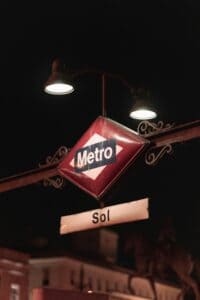
If you plan to visit Puerta del Sol, below are some ways to get there.
Firstly, Madrid has an excellent metro system that can take you anywhere in the city center. You can take Line 1 (light blue) or Line 2 (red) and alight at the Sol station. This puts you at Puerta del Sol’s doorstep – all you have to do after exiting the train is follow the signs.
Another way to reach Puerta del Sol is by bus. The city’s many bus routes pass through it, making it convenient for commuters and tourists. Depending on your location, the lines that stop at this intersection include 1, 2, 3, 5, 15, 20, 44, 46, or others. Consider taking Bus number 53 if you are coming from Retiro park, as it takes you directly to Puerta del sol square with fewer stops and longer intervals between buses than other routes.
If walking is your preferred means of transportation while exploring a city’s charms, then choosing Madrid center for exploring would be ideal because of pedestrian-friendly areas connecting many emblematic places, including Plaza Mayor, which is only a few blocks away from Puerta Del Sol via calle Arenal.
Unlike other cities where traffic congestion affects travel times from point A TO B, Enjoying Madrid on foot will create unique opportunities to explore city landmarks such as the Plaza Mayor market zone, where visitors can buy authentic food items that haven’t been exported from Spain.
The quickest way is by taxi or Uber, which will save time but cost more than public transport alternatives within the Madrid Downtown area as these options are subject to peak-hour prices or sudden fare hikes depending on the supply-demand dynamic ratio during any particular hour, which might result in exorbitant prices for transport.
Why is the Puerta del Sol famous?
Puerta del Sol is famous for being the physical and symbolic heart of Madrid, Spain. Located in the old city center, it is a bustling area full of history, tradition, and culture. Over time, Puerta del Sol has become a significant meeting point where Madrilenians celebrate special occasions and engage in traditional activities – including attending the clock striking twelve on New Year’s Eve. Consequently, Puerta del Sol is now often recognized as Madrid’s most iconic and bustling square, with many tourists visiting to admire its historical charm.
Is the Puerta del Sol the center of Spain?
The Puerta del Sol is a central square located in the Km 0 of Madrid, Spain, commonly known as the “heart” of the city. Although it is not the literal geographical center of Spain, it is a cultural and political center where many rallies and protests take place with great national impact. It has also become a recognized symbol for all Spaniards as its round shape made from eight streets represents the eight ancient roads that led to different cities in medieval times.
Why is it called La Puerta del Sol?
La Puerta del Sol, meaning “The Gate of the Sun” in Spanish, is a public square in Madrid, Spain. It got its name from a former main entry gate into the walled city of Madrid when it was first constructed in 1766. According to legend, the area was named after a statue supposedly depicting a sun god erected by Phillip II when entering Madrid for a military victory parade. The gate was demolished in 1868, and the City Council decided their new modern monument should take its name from the original gate. It has since become an iconic landmark for Madrid and symbolizes the beginning of two important roads – one leading northwest towards Corunna and another southeast towards Andalusia.
In what neighborhood is Puerta del Sol located?
Puerta del Sol is located in the historic district of Madrid, aptly named Centro or Madrid Centro, which makes up the oldest part of the city. It is bounded by Calle Alcala to the south, Plaza Carmen to the east, and Calle de Preciados and Carrera de San Jeronimo to the West. The busy pedestrian area offers attractions like the downtown Real Monasterio de la Encarnacion, Plaza Mayor and Puerta del Sol monument.
What is the significance of the statue of the bear and the strawberry tree?
Symbolism is significant in art, and the statue of the bear and the strawberry tree in Madrid is an example of this. This work of art represents the coat of arms of Madrid, which includes a bear eating berries from a tree. The sculpture comprises several parts that come together to form a stunning piece: a bronze bear, a white trunk representing the strawberry tree, and bright red fiberglass strawberries symbolizing every citizen of Madrid. This work draws attention to how nature and wildlife are still present right at the heart of inner-city life-an important reminder that humans cannot overlook natural beauty without losing touch with what makes us human.
What are some popular restaurants in Puerta del Sol?
One highly recommended restaurant is Botín, the oldest continuously operating restaurant in the world, known for its succulent roast pig and traditional Spanish cuisine. Another popular spot is Casa Labra, famous for its croquettes and fried cod. Visitors also frequent Mercado de San Miguel, a covered market with numerous food stalls featuring delicious tapas and fresh seafood. Taverna del Norte offers a cozy atmosphere and serves classic Spanish dishes like paella and grilled octopus. Ouh Babbo provides flavorful Lebanese cuisine in a welcoming environment if you’re craving Mediterranean fare. Finally, La Pulperia de Victoria boasts mouthwatering Argentinean steaks and other Latin American specialties in a rustic setting that will not disappoint.
What is the best time to visit Puerta del Sol?
The best time to visit Puerta del Sol is during the off-season months, from December to February and July to August. During these periods, fewer tourists clog the streets, and the climate is generally mild enough for strolls through the area. Additionally, visiting early in the morning or late at night may provide a less crowded experience and enable visitors to enjoy iconic landmarks such as the clock tower and statue of King Charles III or take in the vibrant atmosphere of bustling Madrid without fighting off hordes of other tourists.
Is Puerta del Sol safe at night?
Safety at night in Puerta del Sol concerns visitors and locals alike. While it is generally safe during the day, the area can become more crowded and unpredictable at night. It is important to be aware of your surroundings, keep valuables concealed, and avoid suspicious behavior. In addition, it may be helpful to stick to well-lit areas and stay with a group if possible. While it is not without risks, exercising caution and vigilance can help ensure a safer experience at night in Puerta del Sol.
How much time should I spend in Puerta del Sol?
Optimally, spending 2 to 3 hours in Puerta del Sol would allow ample time to explore the central plaza and take in its historical significance. Visitors can admire the clock tower, the equestrian statue of King Carlos III, and the bronze plaque marking Madrid’s Kilometer Zero. Street performers often entertain crowds as well. However, depending on their preferences, those with specific interests, such as shopping or culinary experiences, could choose to stay longer or shorter. With convenient access to nearby attractions such as Plaza Mayor and Gran Via, a visit to Puerta del Sol can easily be incorporated into a full day of sightseeing.
In conclusion, the Puerta del Sol is one of the best places to visit if you want to explore the heart of Madrid. From its captivating history and monumental architecture to its vibrant nightlife and bustling shopping districts – there is something for everyone! Take some time to explore this beautiful city and experience all it offers. Thank you for joining us as we explored Madrid’s Puerta del Sol. Until next time!

Aria Jimínez Mendoza is a passionate explorer of Madrid and the founder of Fringe Madrid. Originally from Madrid, she has spent her life studying and experiencing the city's rich history, culture, and arts.
Similar Posts
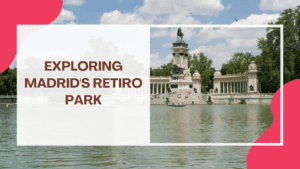
Exploring Madrid’s Retiro Park: A Complete Guide

Short Layover in Madrid? Best Things to Do Near the Airport
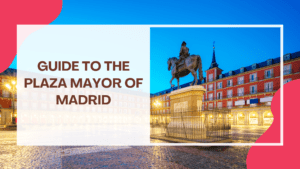
Your Guide to Plaza Mayor, Madrid’s Heart, and Soul
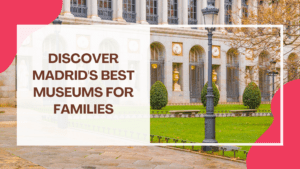
Discover Madrid’s Best Museums for Families: A Comprehensive Guide
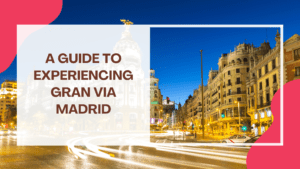
From Landmarks to Boutiques: A Guide to Experiencing Gran Via Madrid
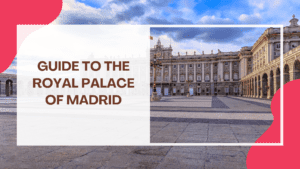
A Complete Guide to Visit the Royal Palace of Madrid
Leave a reply cancel reply.
Your email address will not be published. Required fields are marked *
Save my name, email, and website in this browser for the next time I comment.
This website uses cookies to improve your browsing experience and analyze the use of the website. Learn More

Self-Guided Walking Tour of Madrid

This post is a free, self-guided walking tour of Madrid’s old city center.
You can complete this tour in 60-90 minutes, but you may want to take more time to explore various stops.
This tour will take you to 12 historic locations in the old city center, through pedestrian-friendly streets.
You’ll pass by bustling squares, restaurants, bars, churches, theaters, and impressive architecture.
Enjoy touring this walkable and friendly city!
The map below can be downloaded. If you would instead like a live tour guide, there are several that could be arranged here.
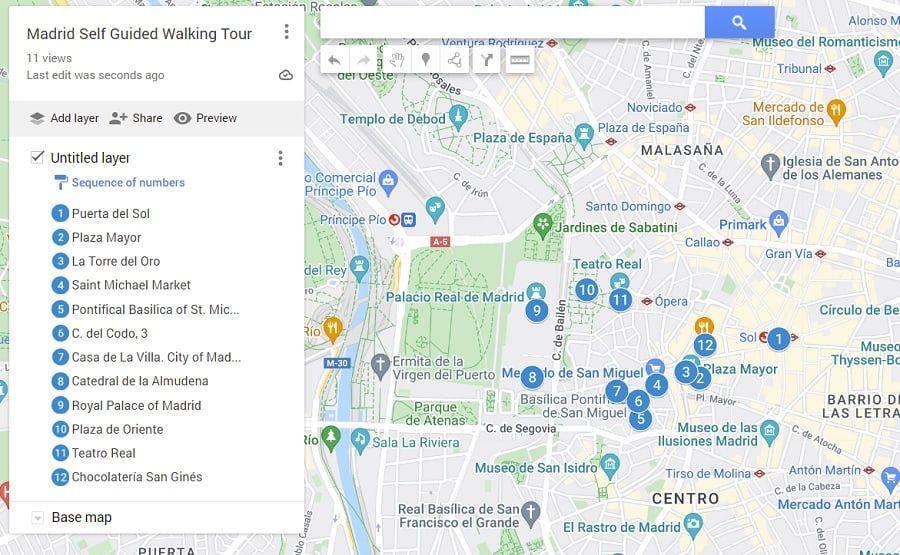
1. Puerta Del Sol
We begin our tour at Puerto Del Sol, Madrid’s most famous square and what some refer to as the heart of the city.
The name Puerta Del Sol (Gate of the Sun) comes from one of the old gates of the city, over which the sun would shine brightly into the square.
Stone buildings, today inhabited by expensive apartments and offices, stores, and restaurants, surround the square.
These were renovated in the 19th century, and plans were in place for further renovations in 2022.
A highlight is the Casa de Correos (the old Post Office), now the headquarters of the Madrid City council and the office of the President.
Its clock tower and chiming bells ring in the New Year, as huge crowds gather in the square to celebrate.
With each ring revelers eat a grape, consuming 12 in total at midnight.
Also towering above the square is a massive sign with a guitar-playing bottle wearing a hat.
This neon sign from the 1930s advertises Tio Pepe, “sol de Andalucia Embotelledo!” (“Andaluain Sun in a bottle!”), a brand of sherry.
The sign proved so popular that when it was removed in 2011, more than 50,000 people campaigned to have it returned.
The square itself marks kilometer zero from which distances in Madrid are measured and Spain’s 6 national roads radiate out.
You can find a plaque commemorating this on the ground outside of the clock tower.
A bronze equestrian statue of King Charles III, one of Spain’s most popular rulers, stands in the square.
He was an enlightened King, one who strengthened Spain’s military, introduced progressive reforms and public works to the city, and is remembered as “el Mayor Alcalde de Madrid” (the Best Mayor of Madrid).
Also on the square is a sculpture from the late 20th century of a bear and a strawberry tree.
People line up to rub on and take pictures of this beloved statue.
This statue is modeled on an ancient symbol of the city, one that first appeared on the city coat of arms in the 13th century.
On the western corner of the square is a white marble statue known as La Mariblanca, the last remaining remnant of a fountain that used to be located in the square.
All that is known about the statue is that she was originally sent from Italy in 1619.
Whether she depicts Diana or Venus is unknown, so her name, meaning “virgin” and “white” was given as a representation of faith and success.
Once you are ready to move on to the next stop, go to C. Mayor, the street running on the south end of Puerta del Sol.
Walk east for about a block then turn left onto C. de Esparteros. Stay on this until you see the first right, C. De Postas.
Follow that for two blocks until you come across the Alpargatus shoe store. Turn right just past this onto C. de le sal, following it into Plaza Mayor.
2. Plaza Mayor
This ochre-colored three-storied rectangle-shaped and arcaded square with 237 wrought iron balconies was the original main square of old Madrid.
Restaurants and cafes selling traditional though expensive food are close by, and shops line the porticos.
During the day the bustling square sees locals who live and work in the area, tourists, street artists, pick-pockets, and other colorful characters.
At night it has a more festive atmosphere as folks visit nearby bars.
The history of the Plaza dates back to 1577 when King Philip II commissioned its construction.
It has seen multiple architects and rebuilds due to fires, with the current neoclassical version having been designed by Juan de Vaillanueca in 1790.
The cultural importance of the plaza can not be understated.
It has seen such events as bullfights with 50,000 attendees, public executions, festivals, religious processions, tournaments, parades, concerts, and Christmas markets.
Occupying the prominence in the center of the square is a statue of Philip III, dating from 1620. Philip was of the Habsburg line and succeeded his father Philip II in 1598 at age 20.
He was generally a disappointment as a leader, but the statue, a gift from the Grand Duke of Florence, celebrates his contribution towards the construction of the square.
One building that escaped a fire that swept the square long ago, the Casa de la Panaderia (Bakery), can be found on the north side of the square.
It was originally built to house the powerful Bakers Guild.
Baroque in design, it is colored with frescos of mythological characters. Inside is the Salon Real, decorated in frescos and tapestry, a place to hold weddings and receptions.
There is also an event space and an air-conditioned tourism office within.
The building can be entered for free between the hours of 11:00 to 14:00, and again from 17:00 to 19:00.
Moving on, on the northwest side of the square you’ll find our next stop.
3. La Toree Del Oro Bar Andalu
This is one of the iconic bars on the square.
It’s touristy, expensive, and packed full of memorabilia celebrating the ancient and controversial activity of bullfighting.
Inside you’ll find videos of some of Spain’s greatest bullfighters in action, photos of famous bullfight attendees like John F. Kennedy, Jr. and Che Guevara, a matador costume, and mounted bull heads.
Beer, wine, sangria, and racións (individual-sized portions) of food are on offer, though keep an eye on the prices!
Hours are 11:00 (am) to 1:00 (am).
For our next stop, on the northwest side of the square find Calle de Cdad. Rodrigo, a street radiating west that you will follow for one block.
It runs into C. Mayor, where you’ll turn left and walk a block.
There on your right, you’ll find Mercado de San Miguel.
4. Mercado de San Miguel
This over 100-year-old ornate cast iron and glass market, just a short walk from Plaza Mayor, sees over 10 million visitors a year.
What was once a local food market was recently renovated and is now home to up-market food vendors hawking regional delicacies.
In this vibrant market, you will find gourmet cheeses, fruits and vegetables, tapas, paella, gazpacho, empanadas, olives, seafood, shaved ham, coffee, Spanish wines, bakery goods, and many other culinary treasures.
It’s best to take cash although keep an eye out for pickpockets!
Seating can be hard to find at times but food can be taken to go.
The hours are Sunday- Thursday, 10:00 AM to midnight, and Fridays-Saturdays (and holiday eves), 10:00 AM to 13:00 PM.
Our next stop is also close by. On the southwest corner of the Market is the street called C. Del Conde de Miranda.
Follow that south for one block until you come to Pl. Del Conde de Miranda.
Walk one block and turn left onto C. de Puñonrostro.
At the end of the block on your left is the Basilica of St. Michael.
5. Basílica Pontificia de San Miguel (Basilica of St. Michael)
This small but stunning Roman Catholic church was commissioned by The Archbishop of Toledo and opened in 1745.
Its design is significant due to the convex shape of its facade, Spanish Baroque design, and Italian influence.
The not particularly interesting exterior displays Saints Justo and Pastor, aged 7 and 9, who were martyred in 304, along with four
allegorical statues representing faith, hope, charity, and fortitude.
The Rococo interior is most impressive though, with colorful stained glass windows, stucco imitating marble and gold, a Latin cross floor plan, frescoes, sculptures, and a bell tower.
The temple hours are:
September 29 - June 30 - Monday-Saturday 9:45-13:15 and 19:30-21:15, Sunday and Public Holidays 9:45-14:15 and 18:00-21:15
July 1 - September 28 - Monday-Saturday 9:45-13:00 and 18:00-21:15, Sunday and Public Holidays 9:45-13:30 and 18:30-21:15
Admission is free.
On to our next stop. Walk back up C. de Puñonrostro heading north.
A few doors past the Iglesia Corpus Christi on the left, and just as the road name changes to C. del Codo, you’ll find something quite special.
6. Sweets at Monasterio Del Corpus Christi
To partake of a divine delicacy, and what some call the “hidden nun cookies”, stop at the chocolate brown door marked “No. 3” on Calle del Codo, just past the Monastery of Corpus Christi.
The cloistered nuns of the 17th-century monastery sell traditional cookies using recipes dating back to Roman times.
There is a sign saying “Horario: Venta de Dulces” on the door. Press the button above that says “Monjas” (meaning “nuns”).
Ask “dulce?” to find out if they are selling sweets that day. If they are, a door buzz gains you entrance to an interior hallway.
Follow the “Torno” signs until you reach a window in a wall with a lazy-susan inside. This is where you will place your order.
Press the buzzer and wait until you hear footsteps. As the nuns have taken a vow of silence, the conversation will be limited.
You won’t see the person who greets you but you need only read your order off of the menu tacked on the wall next to the door.
Orange-flavored cookies, shortbread biscuits, almond biscuits, and more are on offer.
When the lazy susan turns it will have your order. Place your cash (credit cards are not accepted) next to the bag and it will turn again.
It will turn a third time returning the cookies and any change you are owed.
It’s best to go early in the day so you have a larger selection. Late in the day, your options may be limited.
The hours are 9:30 to 13:00 and 16:00-18:30.
Your next stop is just around the corner.
Continue north onto C. del Coto. It runs directly into the plaza in front of Casa de la Villa.
7. Casa de la Villa
The Hapsburg-style baroque Casa de la Villa stands on Plaza de la Villa, one of the oldest squares in Madrid.
King Philip IV granted a license for the construction of this granite, brick, and wrought-iron building.
Work started in 1645 and wasn’t completed until 1693.
For hundreds of years, it served as the city’s old town hall and prison.
This can be noted in its two front doors, one originally for community business and the other for the prison, each topped with the Madrid coat of arms.
Balconies were added in 1789. This colonnaded gallery served as a viewing spot for kings to watch religious processions.
Although the city moved the town hall elsewhere in 2007, the building is still at times used for official business.
The impressive interior includes paintings by such artists as Goya, 17th-century tapestries, marble statues, and an incredible stained glass roof.
There are free guided tours in Spanish and English on Mondays at 17:00.
After you are done with Casa de La Villa, head towards C. Mayor and turn left onto that road.
You’ll see our next stop a few blocks away, just across C. de Bailén.
8. Catedral de Santa Maria la Real de la Almudena (Almudena Cathedral)
This massive-domed gray cathedral is the most important religious building in Madrid.
It is named for the patron saint of the city, the Virgin of Almudena, a statue of which can be found in an impressive altarpiece in the interior.
King Felipe II, who had moved the capital of Spain from Toledo to Madrid back in 1561, had been the first to desire a cathedral at this location.
Delays meant that over time the purpose of the church changed.
It wasn’t until 1883 that the first stone was eventually laid.
During that time and through construction the building’s design and aesthetic were overseen by at least six architects who blended varying styles of architecture (Neo-Classical, Gothic revival, neo-Romanesque).
Due to the deaths of key players, general economic issues, and the Spanish Civil War, it took over 100 years to finally complete.
It wasn’t until 1993 that Pope John Paul II consecrated the church.
Inside one finds an unexpectedly modern interior of white walls, modern artwork, and a colorful ceiling.
There is a permanent exhibit of religious art in the museum, including paintings, vestments, and ancient documents.
You can also climb up to the cupola in the dome of the cathedral and find stunning views of city rooftops, the Royal Palace, old city walls, and the hedges of Plaza de Oriente.
In the extensive crypt, found opposite the Arab Walls at the rear of the building, lie some of Spain’s noble and notable families.
With tall ceilings, a sea of 400 columns, 20 decorated chapels, hanging lamps, and stained glass, the crypt is particularly picturesque.
One of its most special pieces is a painting of Our Lady of the Fluer-de-lis that some believe dates back to the 11th century.
A small donation of €1 is requested for entry and access to the cupola is an additional €6.
From September-June the hours are 10:00 to 20:00 every day
From July-August, the hours are 10:00 to 21:00 every day
Visitors are not allowed during religious services.
Our next stop is just next door, also on C. de Bailén.
Walk north and on your left you’ll find the Palace.
9. Palacio Real (Royal Palace of Madrid)
The Royal Palace is mainly used for state functions, with ceremonies, receptions, banquets, and other official business taking place within.
This massive and stunning palace is the official residence of the Spanish royal family, although they live at the Palace of Zarzuela in Madrid.
Originally on this site was a Moorish fortress built in the 9th century by Emir Mohamed I
It included a walled area of over 40,000 square meters, a mosque, a castle, observation towers, and residences.
Over the centuries modifications were made and the fortress became home to various Castillion Kings.
The old castle was used as the base of a new building, the Royal Alcázar, with the size growing 20 percent larger.
This wood structure would eventually burn to the ground on Christmas Eve 1734.
It was then that King Felipe V commissioned an architect to design a new palace befitting a now-wealthy Spain.
Influences in its design were found in drawings of the Louvre, in the French Baroque architecture of Versailles, and in the works of Italian architect Bernini.
Construction started in 1738 and continued for 17 years.
Today this palace is one of the grandest in Europe, with over 3,400 rooms covering 1 million square feet.
It was designed with a large interior courtyard with wings and was built of materials such as gray and white stone, Spanish marble, golden stucco, and mahogany.
Paintings and frescoes were added by leading foreign artists of the time.
Rococo rugs, velvet hangings, mirrors, bronze decor, sculptures, and golden thrones add to the opulence with elegant gilding and rich decorations filling every space.
Inside one can visit a Royal armory, a gallery of paintings, the impressive 70-stepped main staircase, a royal chapel, a porcelain room, the throne room, staterooms, royal bed chambers, and gardens. There is also a changing of the guard.
Visit the official website for the palace for hours. They vary according to season, day, place within the castle, and cost of tickets.
Tickets range from free under some conditions to 12 €.
Audio guides are available.
Just across from the palace and C. de Bailén is our next stop.
10. Plaza de Oriente (Orient Square)
This tranquil and ornamental garden sits across from the Royal Palace, atop the remains of an eleventh-century Arab watchtower.
It was designed by Juan Bautista Sachetti, the architect of the palace, although not built until Napoleon Bonapart’s brother, King Joseph I, came to rule.
He was often called King Plazuelas (little plazas) because of his fondness for razing buildings so he could build plazas like those found in Paris.
56 structures were demolished to make room for this park.
Over the years, successive monarchs and architects would make changes and additions to the layout and design of the garden.
Limestone statues that had been originally planned for the top of the palace were eventually moved to the park when found to be too heavy for the roofline.
There are 44 of these statues lining the walkways, made up of both Visigoth and Spanish Kings.
At the center of the park is a statue of King Philip IV designed by Pietro Tacca, an Italian sculptor.
It was a marvel of its time in that it was the first equestrian statue to stand on two legs.
Mathematical equations needed to be done due to its weight, so Tacca consulted his friend Galileo.
They were together able to decide how metal was needed and how it would be weighted to stand properly on its back legs.
The park is the perfect location to sit and relax under the magnolia and cypress trees, and amongst roses, hedges, and fountains.
Entry is free.
At the east end of the park, you’ll find the Royal Theatre, our next stop.
11. Teatro Real (Royal Theatre)
Sitting between the Plaza de Oriente and Plaza de Opera is the sarcophagus-shaped and majestic Teatro Real.
It took over 30 years for the theater to be constructed due to a lack of resources, the death of more than one architect, and various political events.
Queen Isabel II, an opera lover, finally demanded that construction be completed in 1850.
The building has served as home to operas, concerts, ballets, and dancehall, and today holds a significant international reputation.
It sits atop an aquifer that while causing structural issues in the past has helped in what is considered world-class sound.
Inside is an Italian-style main auditorium with space for massive scene changes, administrative offices, meeting rooms, dressing rooms, rehearsal studios, a restaurant, and a smaller second theater.
At various points in its history, the theatre has had to close such as during the Spanish Civil war when it was used to house an arsenal.
The building has also seen extensive restorations and refurbishments over time, the most recently completed in 1997.
Today it exists as a major opera house with close to 1750 seats in its main concert hall alone.
Tickets for the opera can be purchased online or at the box office.
Those wanting to tour the building can visit the terrace and its well-reviewed restaurant situated in the old ballroom. If you’re lucky you’ll be there while the orchestra and singers are practicing
Tours can be had in English, French, and Spanish and cost between €8 and €10.
- Spanish : Monday to Sunday at 10:00 am and 12:00 pm / Wednesday: 2:00 pm.
- English : Monday, Tuesday, Wednesday, Thursday, Friday, Saturday, and Sunday at 10:00 am.
- French : Tuesday at 10:00 am
When ready to move on to our next stop, walk around the backside of the theater to the Plaza de Opera.
On the south side of the plaza find C. Del Arenal and take that east, heading away from the direction of the Palace.
This pedestrian street has shops, hotels, restaurants, churches, clubs, a well-known bridal shop, and more.
Follow this just a few blocks until you see the red brick church on the right called Parroquia de San Grinés.
Immediately past the church, turn right onto Pasadizo de San Ginés and walk to the end of the first block to #5
12. Chocolatería de San Ginés
One of Madrid’s most authentic and popular cafes can be found in the building where they first began serving their treats in 1894.
At one point called “La Escondida” (The Hidden One) by locals, this establishment is so beloved it has made appearances in Spain's literary offerings, and the walls are lined with pictures of the famous faces who have visited.
The look of place is an authentic 19th-century cafe with white marble countertops and green walls with mirrors.
The cafe's most well-known offering is hot chocolate and churros or porras, traditionally eaten for breakfast but served all day.
This thick pudding-like chocolate is served in a coffee cup which the churros or porras are dipped into.
Addictive is a word often used and an average day sees thousands of portions served to tourists and locals alike.
Also offered are additional gourmet chocolate products, ice cream, and refreshments such as coffee and beer.
Tables can be found inside across two floors and outdoors on the sidewalk. Food can also be taken to go.
Before the pandemic it was open 24 hours a day, 365 days a year, making it a pull for early-morning revelers closing a long evening, and late-night workers.
It is currently open from 9:00 to 23:30, and can be delivered through Uber eats up until 23:00.
To complete your tour, return to C. del Arenal, turn right, and walk just a few short blocks.
You’ll find yourself back in Puerta del Sol where we began our tour.
Choose a Destination... I want them all PLUS general travel tips. Amsterdam Berlin Boston Charleston Chicago Dubai Lisbon London Los Angeles Miami Nashville New York City New Orleans Paris Philadelphia Prague Rome San Francisco Washington DC
About The Author

Stephen Pickhardt
North america, united kingdom & ireland, middle east & india, asia & oceania.

- Collections
- Hotel Solutions
- Become a partner
- Become a guide
- Guide Dashboard
- Agent Portal
- Hotel Portal
Puerta del Sol
Travelcurious tip.
This is the transport hub of Madrid, and makes for an excellent central rendezvous.
The heart of Madrid
The Puerta del Sol originated as one of the gates in the city wall that encircled medieval Madrid: it got its name from the rising sun which decorated the entrance, as the gate was oriented to the east.
Today a busy and vibrant spot at the centre of the city, Puerta del Sol offers a fine range of shops, restaurants and cafés down its side streets, an array of entertainments in the square (the typical street-performer cast of mimes, human statues and magicians vie for tourists' attention) and great opportunities for people-watching throughout.
All road lead to Puerta del Sol
In front of the Post Office, which serves as the office of the President of Madrid, is a plaque in the pavement marking the starting point of all the roads in Spain: they all radiate out from here like the rays of the sun. Its central and symbolic location has made the square a popular spot for protest and demonstrations in recent years.
The square is also home to a famous clock, whose bells sound for the Spanish tradition of the eating of the Twelve Grapes and the beginning of a new year. The New Year's celebrations held in the square has been broadcast live on national TV since 1962. On the east side stands a statue of a bear and a madrone tree ( madroño ), the heraldic symbol of Madrid; another landmark is the huge neon-lit advertisement for Tío Pepe, a brand of sherry, which has dominated the square since 1936.
Nearby Attractions
Related tours.
- Enjoy the personalised attention of your private guide.
- Set out to taste your way around Madrid’s delicious local tapas bars , taverns and restaurants , as recommended by your local guide.
- Explore the highlights of Madrid at the same time, including the imposing Plaza Mayor , the awe-inspiring Royal Palace, the stunning Gothic Catedral de la Almudena , and stop in at the amazing San Miguel food market.
- Learn all about Spanish cuisine , wine and beer , and the history of its culinary favourites like Jamon Serrano, tortilla, croquetas, Padron peppers – all while tasting as you tour!
- Enjoy a refreshing Spanish wine, beer, or sangria to accompany your tapas plates.
- End at a local tapas bar , and get recommendations from your guide to explore further.
- Begin your tour at the vast Plaza Oriente at the mighty equestrian statue of King Philip IV in the heart of Madrid;
- Admire the awe-inspiring Gothic Catedral de la Almudena surrounding the square;
- Hear stories of the Royal family as you stand at the doors of the exquisite Royal Palace which served as a Royal Residence until the early 20th century;
- Stop in front of the magnificent Teatro Real (Royal Theatre), which is considered one of the most important opera houses in the world;
- Wander down the elegant boulevards , pausing by monuments, markets and other marvels!
- Enjoy the vibrant buzz of Mercado de San Miguel, a bustling market to sample some of the best local food and wine;
- Stroll through the iconic Plaza Mayor in the heart of the city, admiring the stunning architecture of the surrounding buildings with its elegant porticos;
- Head to Puerta del Sol, the geographical centre of Spain and another iconic square;
- See Puerta de Alcalá , a beautiful neoclassical monument and one of the most popular landmarks of Madrid;
- End your tour at Parque del Retiro , and discover its amazing lake, statues, thousands of trees and gorgeous palatial-style museums.
- See the main attractions of Madrid as you learn about the fascinating history of the city;
- Learn about the history of the Spanish royal family and its links to the Papacy as you stand outside the Palacio Real, the royal palace – considered the most important Baroque palace in Spain;
- See the astonishing Catedral de la Almudena;
- Stop by famous monuments and wander down elegant boulevards;
- Explore Plaza de Oriente, Teatro Real and the Market of San Miguel;
- Experience the grandeur and elegant atmosphere of the iconic Plaza Mayor, the beating heart of Madrid ;
- Admire the myriad of stunning architectural styles in Madrid, from Baroque to Spanish Gothic;
- Enjoy a guided walk around the beautifully manicured Parque El Retiro;
- Arrive at the Prado Museum, and enjoy a guided visit to this treasure trove of art;
- Admire the world-famous Spanish masters such as Bosch, Goya, El Greco, and Diego Velazquez;
- End your tour inside the museum , to continue at your own leisure.
Join the fastest growing community of professional tour guides.
Use our easy to integrate toolset to include Tours & Attractions in your customer journey.

Tour Your Home at UCI
On-campus housing tours.
Take a virtual tour of your home at UCI!

Video and Photo Previews of the Residence Halls
Scroll down for student-produced videos and a variety of photos documenting housing facilities and community life..
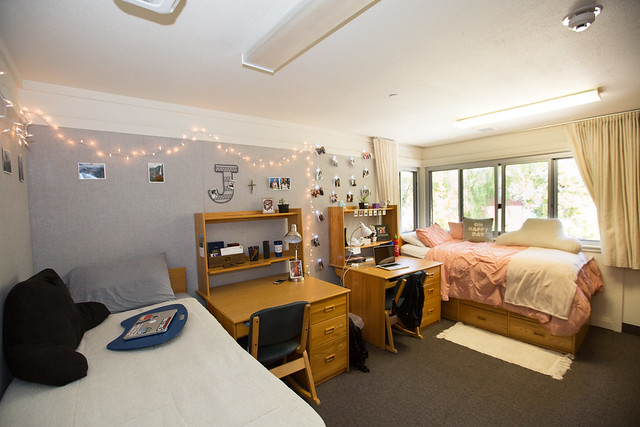

Video Tour of Arroyo Vista Community
Arroyo Vista community photos can be viewed on the Arroyo Vista community page. Arroyo Vista Housing Tours may be scheduled on request. Contact the AV Office at (949) 824-3900 for information.
American Campus Communities
Vista del campo, vista del campo norte, camino del sol, puerta del sol.
Online photo galleries available for each of the American Campus Communities: Vista del Campo Norte , Vista del Campo , Camino del Sol , Puerta del Sol , and Plaza Verde .
Housing Communities Map
Check out the Housing Communities Map to get a closer look at where communities are located across campus.
31699 Via Puerta Del Sol, Bonsall, CA 92003
Acres (Lot)
Cullen Mckeown
Coldwell Banker Realty
949-661-9355
Last updated:
September 27, 2024, 05:28 PM
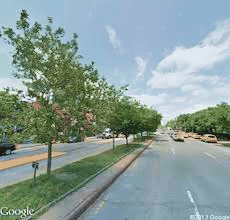
About This Land
Magnolia Ranch – Luxury Equine Estate in San Diego Magnolia Ranch, located in one of San Diego’s premier equestrian communities, offers the perfect blend of luxury estate living, elite horse amenities, and agricultural potential. This 6.5-acre estate features extreme privacy while maintaining easy access to shopping, services, and major roadways. Enjoy year-round ocean breezes and panoramic views of the San Luis Rey River Valley and nearby mountains from this serene property. Designed for equestrian and agricultural use, the property is fully equipped with essential infrastructure, including recently completed grading, retaining walls, roadways, and irrigation systems. There’s direct access to 350 acres of protected land for trail riding and hiking, and the property is ready for commercial equestrian permits. The six-stall MD Barnmaster barn includes modern amenities such as wifi-controlled lighting, Comfort Stall flooring, Nelson Waterers, two wash racks, a tack room, and more. Two riding arenas, a ½-mile exercise track, oversized paddock, and professionally seeded pastures round out the equine facilities. The property also features a custom 3,086 sq. ft. main home that awaits the buyer’s personal touch, with a credit offered for custom finishes. Additional highlights include a 7,500 sq. ft. outdoor entertaining space with a front courtyard, covered patios, a massive deck with a gazebo, built-in jacuzzi, and BBQ area. The oversized two-car garage can easily be converted to extra living space. The 780 sq. ft. newly rebuilt guest house is move-in ready, offering a modern farmhouse style with new appliances, a water softening system, and over 3,000 sq. ft. of private outdoor entertaining space. For added versatility, the property includes a 1,800 sq. ft. commercial-grade workshop with custom cabinetry and a 15-ft roll-up door. A 24-ft commercial-sized entrance with an automatic iron gate and 17,000 sq. ft. of newly paved driveways ensure easy access for large vehicles. New fencing, a central irrigation system, and automatic liquid fertilization enhance the property’s functionality. Magnolia Ranch is a rare opportunity to own a luxurious, private, and fully functional equestrian property in Bonsall. Whether for personal enjoyment or commercial use, this estate offers endless possibilities with seller financing available.
Description/Design:
Lot Size (Acres)
Last Updated:
1 day(s) ago
Finances & Disclosures
See this home in person, attend an upcoming open house, sun, sep 29, contact an agent.
Yes, I would like more information from Coldwell Banker. Please use and/or share my information with a Coldwell Banker agent to contact me about my real estate needs.
By clicking Contact I agree a Coldwell Banker Agent may contact me by phone or text message including by automated means and prerecorded messages about real estate services, and that I can access real estate services without providing my phone number. I acknowledge that I have read and agree to the Terms of Use and Privacy Policy.
- Call Today : (505) 898-5111
- Location : 4816 McMahon Blvd NW Albuquerque NM 87114

- Apartment Search

Schedule a Tour

Travel Tips to Kabardino-Balkaria: More than Mt. Elbrus!
If you’ve traveled to the North Caucasus before, there is a good chance you’ve already been to Kabardino-Balkaria, and you didn’t even know it! Kabardino-Balkaria lies in the center of the North Caucasus region, is home to Mt. Elbrus, but more than that is a treasure chest of travel possibilities. Here is our guide to traveling through the republic of Kabardino-Balkaria, or 9 travel tips to this beautiful land:
1. How do I get there?
Kabardino-Balkaria hosts a large number of both foreign and Russian travelers every year, and has an improving infrastructure able to handle the incoming masses. Let’s start with the obvious. You might be a mountain climber or skier coming to enjoy the slopes of Mt. Elbrus. That means you’re likely arriving on an airplane to Russia. Here are your travel options:
A. Plane – We advise you fly into the Mineralni Vodi (MRV) airport in the Stavropol Region, which is about 45 minutes from the border of Kabardino-Balkaria. MRV is the largest airport in the North Caucasus, and has daily direct flights to and from all 3 airpots in Moscow (SVO, DME, and VKO), direct flights from St. Petersburg, and several international flight routes as well, including from Istanbul, Dubai, Greece, Tel Aviv, and Bishkek. The MRV airport has a growing infrastructure and is the most obvious choice to fly into if going to Elbrus. From MRV, it’s a 2 hr. drive to Nalchik, and a 3.5 hr. drive to Mt. Elbrus.
That being said, the capital of Kabardino-Balkaria, Nalchik (NAL), also has a small regional airport with a daily flight to/from Moscow as well as weekly flights to Istanbul. As is to be expected in most smaller, regional airports around Russia, the service standard at a small airport like this will be minimal. As a result, we recommend you flying in and out of MRV if able. It’s a 2 hr. drive to Elbrus from Nalchik. You can also fly into other regional airports which are 2 hrs. from Nalchik, such as OGZ in North Ossetia (Vladikavkaz) or IGT in Ingushetia (Magas).
B. Car/Public Transport – If you have a car, are using a taxi, or are hitch-hiking your way to Kabardino-Balkaria, the region is accessible by a variety of roads and vehicles. A major Russian federal highway E50 runs through Pyatigorsk into Kabardino-Balkaria, and can take you towards Mt. Elbrus, Nalchik, and deeper into the North Caucasus. There are daily mini-buses, or “marshrutkas”, that travel to Nalchik from Pyatigorsk, Vladikavkaz, Grozny, and Magas, if you’re coming from a neighboring republic. From the main Nalchik bus station, there is a marshrutka that goes to Terskol (i.e. Mt. Elbrus) daily around 12:30 pm; for that matter, marshrutkas run daily into every valley of this beautiful republic. For the seasoned international traveler, you can drive from the country of Georgia up the famed “Georgian Military Highway” through the heart of the Caucasus Mountains, cross the border into Russia at the “Verkhni Lars” border stop, and be in Nalchik in about 2.5 hours as well.
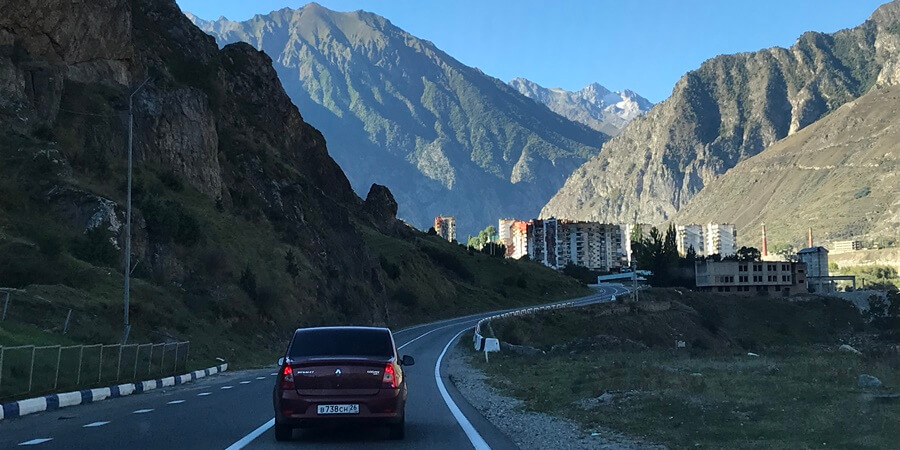
Anyone traveling on their own should download the “Yandex” taxi app, which is Russia’s version of Uber, and has a very user-friendly app with affordable prices. In smaller villages/towns where Yandex’s service doesn’t reach, just ask a local and they’ll direct you to a friend or relative who can taxi you where you need to go!
C. Train – Kabardino-Balkaria is also very accessible by the famous cross-country Russian train system if that’s your preferred method of travel. Almost all trains to the North Caucasus pass through Mineralni Vodi in the Stavropol region to the north, so make sure wherever you are coming from, Mineralni Vodi is one of the stops. Despite Nalchik having a train station, the city is about 45 minutes from the main railway route that runs diagonal through the North Caucasus, and as a result it’s a bit convoluted to get a train directly to Nalchik. That being said, the town Prokhladni is a regular stop on trains going to/coming from Baku, Makhachkala, Grozny, Nazran, and Vladikavkaz, so you can always hop off there and find your way by public transport or taxi.
2. What are the best places to stay?
This list could get exhaustive, fast. 🙂 Let’s first look at an overview of the republic’s geography, followed by hotel recommendations:
A. Nalchik – This is the capital city of Kabardino-Balkaria, with a population of around 250,000. Nalchik is growing and new, modern hotels are being built regularly. Here are some of our recommendations:
-Modern and comfortable: Azimut , Butik Otel
-Budget with less frills: Hotel Rossia , Korona
You could comfortably spend a week in Nalchik, while doing day trips into Kabardino-Balkaria’s beautiful mountain valleys.
B. Baksan Valley – This is the most traveled road in Kabardino-Balkaria, the road to Mt. Elbrus. If you have questions about its safety because of travel warnings, please see our detailed blog here of the drive to erase any doubts or fears. Needless to say, because of the draw of Mt. Elbrus, there are a huge variety of lodging options at the end of this valley, from 4-star to mid-range to budget to hostel. Here are just a few we’ll recommend from our experience:
-Modern and comfortable 4-star-ish: Azau Star , Kristall 139
-Budget with less frills 3-star-ish: Laguna , Povorot
If you’re a mountain climber with your sites set on the summit of Elbrus, you’ll have to spend at least 3-4 nights at Elbrus’s famous base camp at 13,000 feet. The “barrel huts” are not easy to book directly with, and we highly recommend you do your climb (and hence, have your bookings handled) through a trusted climbing company. Here are two shelters at base camp we recommend:
-Modern and comfortable: Leaprus
-Budget with less frills: Heart of Elbrus Lodge
If you’re interested in climbing Mt. Elbrus and staying in these barrel huts, click here to see our climbing itineraries, pricing, and group dates.
C. Chegem Valley – Chegem Valley is the adjacent valley to Elbrus’s Baksan Valley, and is famous for its beautiful waterfalls as well as being Russia’s top paragliding location. The “ Paradrome ” has modest accommodations for those wanting to get to know this beautiful valley for a longer period of time.
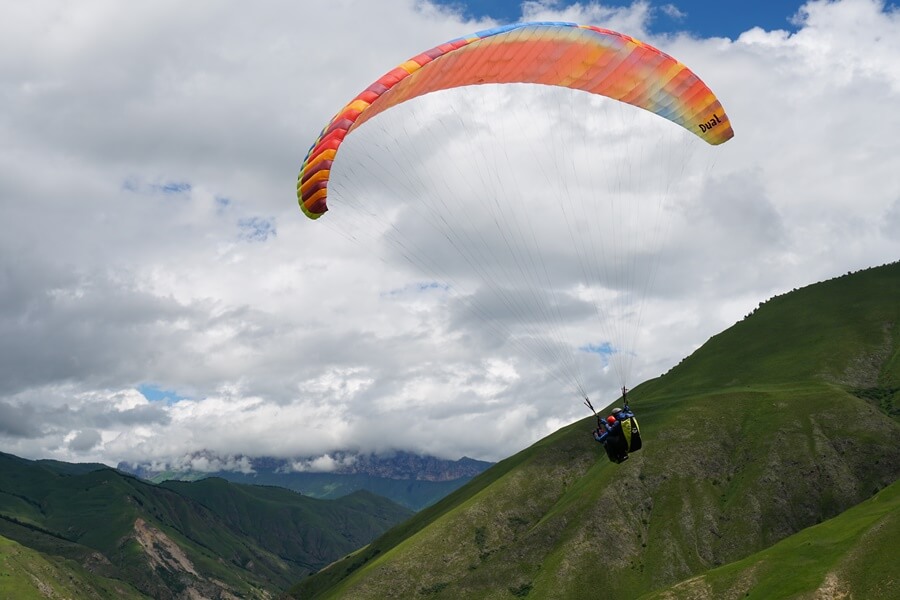
D. Upper Balkaria, or Cherek Valley – This is another beautiful mountain gorge not too far from Nalchik. There is an authentic lodging complex in Upper Balkaria called Tau-El, with amazing local food for meals as well.

E. Border Zone lodging – Several of Kabardino-Balkaria’s mountain gorges run into the border zone with neighboring country Georgia, i.e. an area that foreigners cannot enter without a special permit from the local government (often taking 2 months to receive). There is a famous mountaineering lodge in Bezengi Valley, where several generations of Russian mountain climbers have honed their craft in the Caucasus Mountains. Perpendicular to Baksan Valley (about 25 minutes from the base of Mt. Elbrus) is Adyr-Suu Valley, where there is a lodge for back-country skiers to stay, while trying their hands (and feet!) on the untouched snow of that valley. Both these valleys require border permits for foreigners, but are possible to access for the more adventurous!
3. Top cities to visit?
Most locals would agree that Nalchik is the main city of significance to visit in Kabardino-Balkaria, but let’s be honest, even more would say, “Just go to the mountains!” Tirnauz is the capital of the Elbrus district, and is an interesting town to spend some time in, with its unique location in the mountains and place in Soviet history as a once-booming mining town. The main thing to consider in visiting Nalchik and other cities in the lowlands, is the chance to experience Kabardian culture and food. Whereas the deeper you go into the valleys, the more you’ll encounter Balkar culture and food.
4. Best local foods to try?
There are 3 types of food that come to mind, when spending time in Kabardino-Balkaria:
A. Khychiny – This is one of the staple national dishes of the Balkar people, and what you’ll inevitably be served if guests of local Balkars. It’s a thin buttery flat bread, sometimes cooked with fillings of cottage cheese, fresh greens, or potatoes. It is often slathered in butter, but wow is that some tasty greasy goodness! 🙂

B. Shashlik – Shashlik is a MUST for any visit anywhere in the North Caucasus! Most people would agree that it’s the national food of the entire region. Shashlik is meat shish kabobs; while pork and turkey can be found in some parts of the Caucasus, lamb or chicken are the preferred shashlik meats of choice in Kabardino-Balkaria.
C. Soup – No matter where you are in Russia, you’re sure to find a local soup that people love. Kabardino-Balkaria is no different. Especially in the winter months in the mountain valleys, there’s nothing better than to come inside from the cold weather and warm your body up to a bowl of hearty Caucasus soup. Whether Georgian kharcho or local Balkar lakhman, make sure to try your hand at one of these soups with a side of fresh baked bread/lavash!
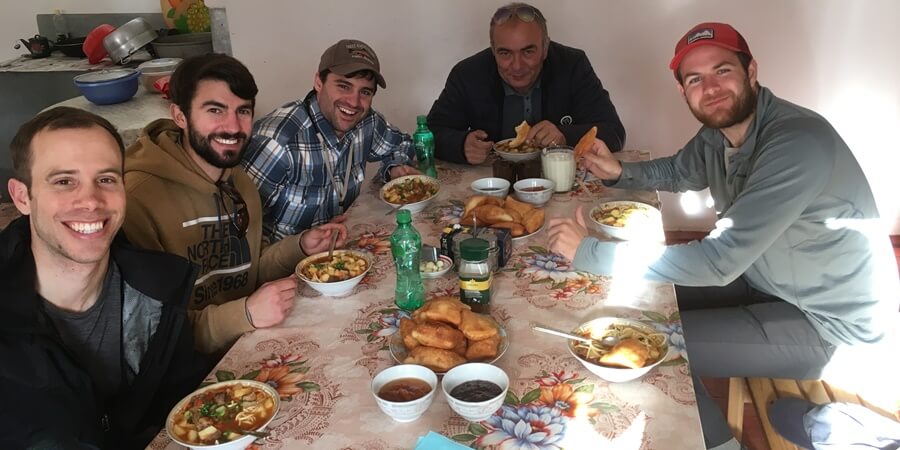
5. Top Hole-In-The-Wall restaurants:
Of course, for a republic of this size, we’re bound to leave at least a few great local joints off our list, but here are a few to get you started. ***Note: Restaurants in the North Caucasus are much better known for their food than their service, so prepare for tasty food, but manage your expectations about service:
-Elbrus – Kogutai Restaurant at Mt. Cheget – While this isn’t a hole-in-the-wall restaurant per se, it’s one of many to choose from in the Cheget tourist village, and we have found them to provide consistently good food and service. Kogutai has a nice interior, and maybe most important, an English-language menu with good pictures. 🙂 There also is a nice outdoor patio with fantastic views of the surrounding mountains.
-Nalchik #1 – Tameris Restaurant – This is a cafe with a relaxed atmosphere in the capital Nalchik. Local tour company Elbrus Elevation has taken foreign groups there on multiple occasions and always had good experiences. Address is ul. Kuliyeva 3.
-Nalchik #2 – Cafe-Bar Oasis – You have to know where this restaurant is to find it, but once inside, you won’t regret it! There is a unique cafeteria-style ordering process, that includes several dishes being cooked on the spot once ordered. You can sample local Kabardian dishes here. The seating area is very modern and a pleasant atmosphere to have a meal in. Address is ul. Kuliyeva 2.
-Upper Balkaria – Tau-El Restaurant – This is the restaurant part of the Tau-El Tourist Complex in Upper Balkaria. Whether spending the night or just passing through, make sure to stop here for a meal!
6. Must-See Sites
This republic is so chock full of “must-see” destinations, it’s impossible to narrow the list down. Here are just a few suggestions to get you started: (***Mt. Elbrus is a no-brainer and we’re assuming that’s on your list)
A. El-Tyubu and Paradrome – This is an amazing area towards the end of Chegem Valley. Many tourists visit the famous Chegem Waterfalls and don’t drive any further down this gorge, which really is a shame. El-Tyubu is a picturesque Balkar village with several historical sites to see, including some ancient mausoleums. The real gem of the area, though, is the Paradrome , which is Russia’s premier paragliding destination. The combination of the scenic surrounding mountains and constant winds produces almost daily conditions to sail through the beautiful Caucasus sky. Highly recommend!
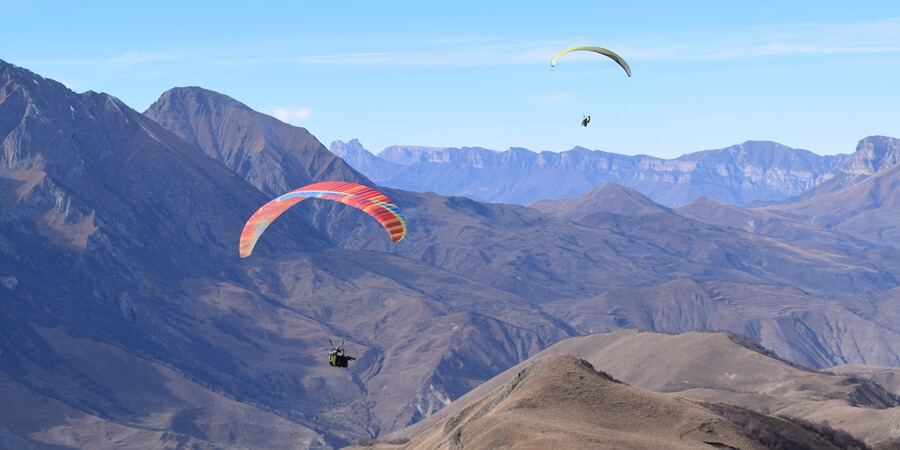
B. Upper Balkaria – Also known as Cherek Valley, the entire drive to the actual village of Upper Balkaria is one big destination. First, you can spend time at the 3 consecutive “ Blue Lakes ”, one of which is one of Russia’s deepest lakes with an underground spring. Then, the drive itself becomes an adventure, as you pass by steep rock walls with a huge drop-off on the other side. If you’re able to walk this part of the road, that is a bonus! Once you’ve made your way through the valley walls, the region opens up into a beautiful panoramic view. Many years ago, there were multiple villages in this region, but they’ve since been condensed into one main village. You can see some of the ancient Balkar towers that their ancestors used to live in as well.
C. Djili-Suu – Although hard to pronounce and not easy to get to, Djili-Suu is one of those places in the North Caucasus that people rave about that you “have to” visit. It’s actually on the North side of Mt. Elbrus, and more accessible from the Mineral Waters region (2 hrs. from Kislovodsk). The base camp for Elbrus climbers summiting the mountain from the North side is at Djili-Suu. This area is famous in Russia for its numerous natural healing springs, as well as unique climate conditions that make for beneficial, long holidays for seeking a respite from their daily grind. There are wide swaths of land available for camping, with probably the most unrivaled views of Mt. Elbrus in the North Caucasus. Make sure to check this out!
7. Off-the-beaten path destinations

A. King’s Waterfalls (Tsarskie), or Gedmisht – Probably the valley in Kabardino-Balkaria with the least amount of hype is the Malka Valley, which is the northernmost valley and mainly runs through the Kabardian lowlands. At the point where the villages end, though (Khabas), the asphalt turns into dirt and the hills start to rise, culminating with the incredible King’s Waterfalls, or as one friend put it, Avatar Waterfalls. These stunning waterfalls are best visited in the early summer, when everything is lush green and the water flow is strong, with many streams of water flowing down the earth’s surface. The different colors are incredible and it’s hard to look away. Once you’ve enjoyed the waterfalls, enjoy a meal of shashlik at one of the nearby lunch huts. Having an off-road vehicle is ideal to visit these falls, but worth the time and effort!
B. One-seater chair lift at Elbrus – As the infrastructure at Mt. Elbrus has modernized, some of the more “authentic” experiences have gone to the way-side. This is one experience still available, though! From the 2nd (11,000 ft.) to 3rd level (12,500 ft.) of Mt. Elbrus (whether skiing, going to base camp, or just touring), there is a single-seater chair lift for 100 rubles each way (less than $2). This is an amazing experience if you have the time. It’s 8-10 minutes each way, and a surreal experience of the majestic Caucasus mountain range surrounding you, skiers silently passing you by underneath, and in general enjoying the silent expanse of nature all around. The chair lifts are from the Soviet times and so it feels like something from a different era. For mountain climbers, the newer group cable car gives better access to most of base camp, but several huts are pretty close to this chair lift, so it still may be a good option for you.
C. Abandoned Mines above Tirnauz – Tirnauz is about 1 hr. from Mt. Elbrus, and a town everyone drives through to and from the mountain. Although today it looks old and half-abandoned, it was a booming mining town in the 20th century. About a 45-minute drive above the city with an off-road vehicle, you can see the remains of the mining operations. Learning about this history combined with the breath-taking views of the Baksan Valley and even into Georgia, you’ll wonder why more people aren’t visiting this place. This is a great spot to see eagles soaring in the sky, as well as admire the Soviet city plan of Tirnauz from above.
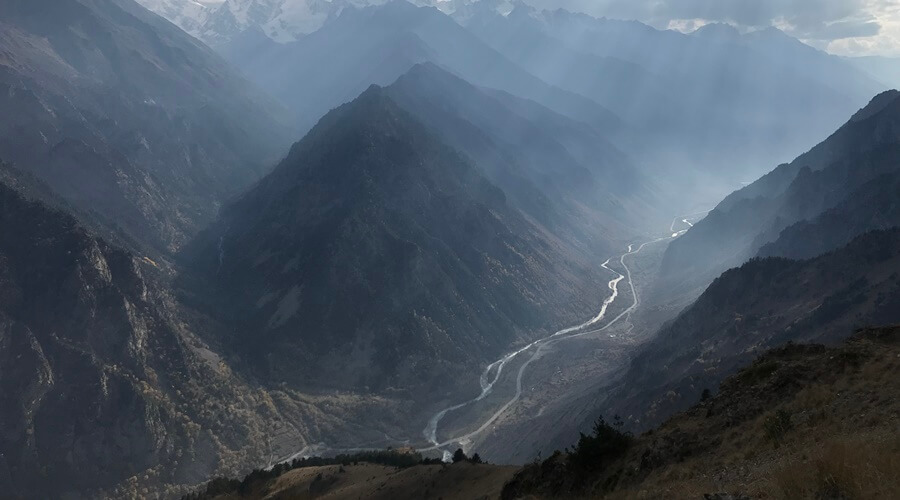
8. What do I need border zone passes to visit?
In Russia, any area within 5-10 km of a neighboring country, without a clearly delineated border (i.e. in the mountains) is considered a special border zone, and patrolled by Russian border guards. This area IS accessible to all Russian citizens with their passports, but is NOT legally accessible to foreign citizens UNLESS you have a special permit from the FSB (Federal Security Bureau). These permits are accessible, either through a tour operator or local friend, but require you to submit your application 45-60 days in advance.
Areas in Kabardino-Balkaria that are worth a visit if you have a border zone pass:
A. Bezengi Wall – This is at the end of the Bezengi Valley, and holds a place of lore among Russian mountain climbers. Many mountain guides go through training in this valley. Five of the Caucasus Mountain’ range’s highest seven peaks are a part of the Bezengi Wall, so you can imagine the draw it has for climbers. There are great areas for trekking and camping in this area.
B. Adyr-Suu Gorge – This remote valley runs perpendicular to Baksan Valley and is about 25 minutes from the base of Mt. Elbrus. It’s marked at the entrance by a relic of the past, a car lift from Soviet days that auto-cranks your car (and you) about 50 meters up the mountain. After 45-60 minutes of driving on gravel road, the gorge opens up into a flat valley with a beautiful view of the surrounding mountains. The Adyr-Suu Alpine Lodge is at the end of this valley and where back-country skiers base out of during the acclimatization phase of their Mt. Elbrus ski tours. This is truly a place where you can experience untouched powder!
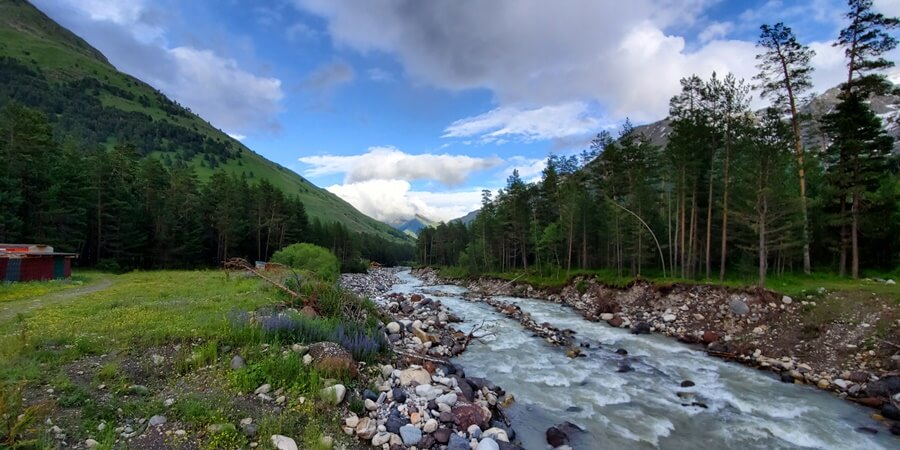
C. Mt. Cheget (Elbrus) – Cheget is a neighboring mountain to Mt. Elbrus and where many climbers will acclimatize, both at its base and while doing some hikes. It also is famous in Russia for its free-ride terrain for more experienced skiers. Standard access to the chair lifts and mountain are available to all (i.e. mountain climbers don’t need to worry about accidentally crossing into the zone), but anyone wanting to summit the peak of Cheget OR visit the beautiful Cheget Lake needs a border permit.

Foreigners violating the border zone areas is considered a serious offense in Russia; make sure to do your due diligence if wanting to visit one of these areas! We highly recommend using a local tour operator and always traveling with a local person if visiting one of these areas.
9. Any cultural “do’s” or “don’t’s” to be aware of
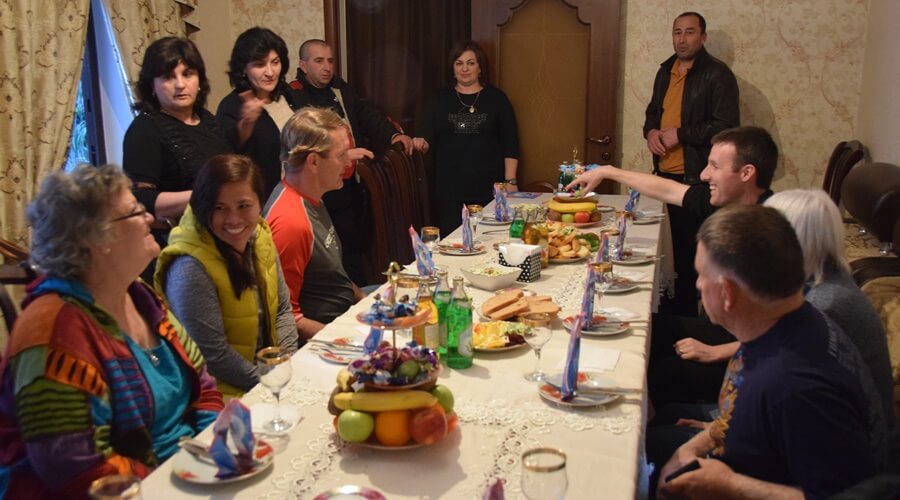
Kabardino-Balkaria is a fascinating republic with a combination of traditional and modern society. The more you interact with local people, the more you’ll see a mixture of Muslim faith, post-Soviet mentality, and ancient local traditions all wrapped together.
Kabardians mainly live in the lowlands (Nalchik, Baksan, and lowland villages), while Balkars primarily live in the mountain valleys (Elbrus, Chegem, Upper Balkaria, etc.). There is a large population of Russians in the region as well. Foreigners visit every area of the region regularly, and so local people are used to and will welcome your presence.
Come with an open mind to learn about these peoples, their traditions, and their land. You won’t regret your trip to Kabardino-Balkaria!

***Want to learn more? Here are several self-published resources from the podcast “ CaucasTalk ” related to Kabardino-Balkaria:
– Travel Tips to Kabardino-Balkaria (audio version of this blog)
– History of Mt. Elbrus (Part 1)
– History of Mt. Elbrus (Part 2)
– Interview with Local Elbrus guide
– Climbing Elbrus: Interview with American guide
– Who are the Kabardians? (Part 1)
– Who are the Kabardians? (Part 2)
– Skiing in the North Caucasus (Elbrus and more)
READY TO EXPERIENCE KABARDINO-BALKARIA FOR YOURSELF?
Where to find us.
- +1 704-810-4296
- [email protected]
- 1578 Pine Creek Rd., Gastonia, NC 28056
Travel Information
- We no longer offer travel services to Russia. See Caucasus Quest Tours for new destinations
- Is it Safe to Travel to the Caucasus in 2024?
- Climbing Kazbek & Kilimanjaro: Comparing two 5,000+ meter peaks
- How to Train to climb Mt. Kazbek in Georgia
Our Elbrus Climbing Tours
- Climb Elbrus South Route
- Climb Elbrus North Route
- Climb Elbrus & The Capitals
- Climb Elbrus & The Caucasus
Russia Cultural Tours
- Capitals of Russia
- Lake Baikal on Ice
- Delightful Dagestan
- Heart of the Caucasus
ALL Travel Services to Russia and Mt. Elbrus have been indefinitely suspended as of Feb. 2022.
Explore our new tour branch Caucasus Quest to climb Mt. Kazbek (5,054 meters) in Georgia or for immersive cultural touring experiences in Georgia, Armenia, and Azerbaijan.
- Bahasa Indonesia
- Slovenščina
- Science & Tech
- Russian Kitchen
9 places in Kabardino-Balkaria every adventurer needs to visit (PHOTOS)
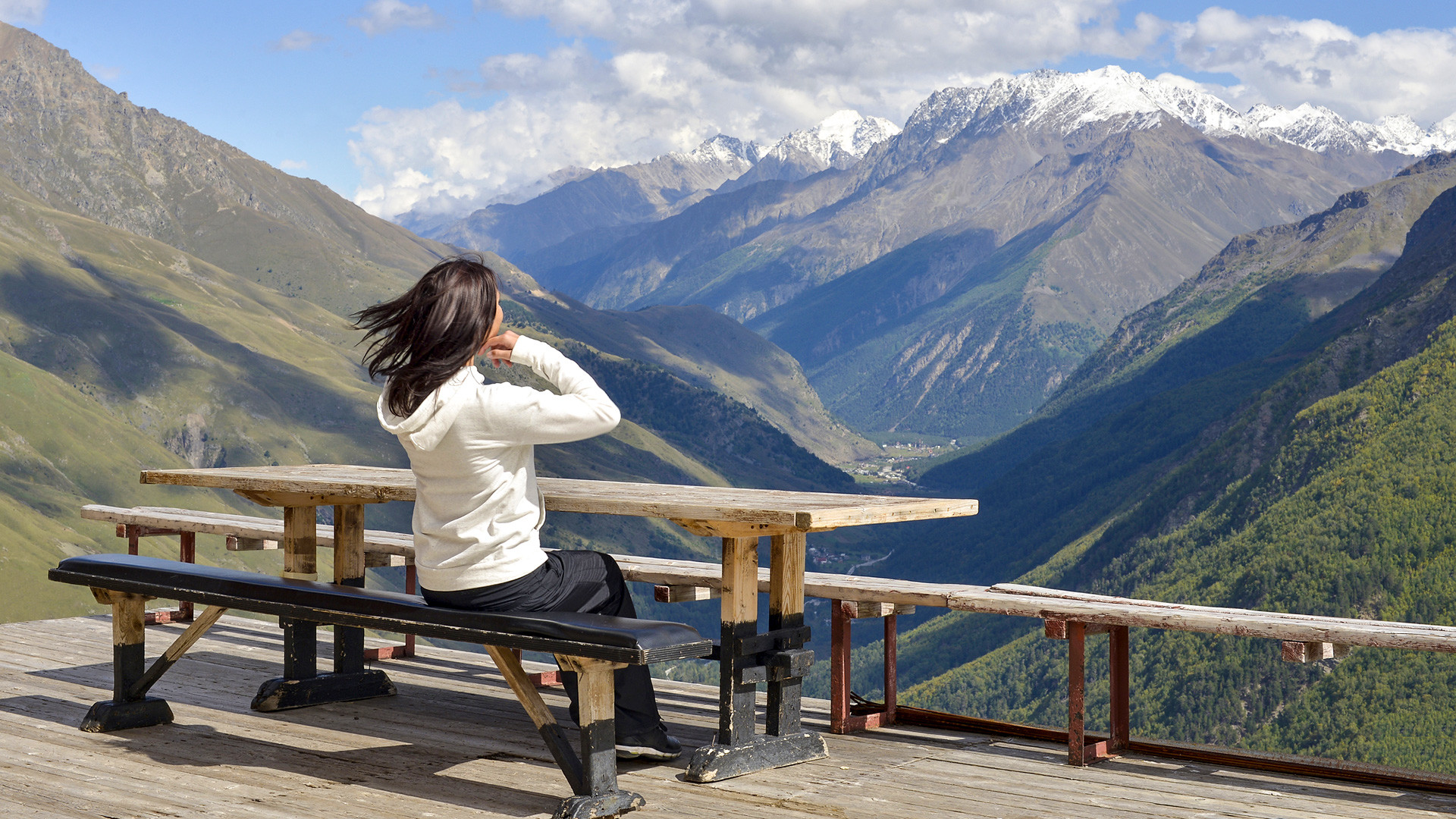
An amazing journey through the mountains of Kabardino-Balkaria.
Together with local tour guide Artyem Babaritsky, we show you why this is one of the most underrated regions of Russia. According to Artem, the nature on the territory of Kabardino Balkaria is more “rigid” and “serious” than in the neighboring republics of the Caucasus. This is comparable to a human face: one moment it is kind and smiling (while we are in the Karachay-Cherkessia) and then suddenly this kind face starts to frown and becomes more severe.
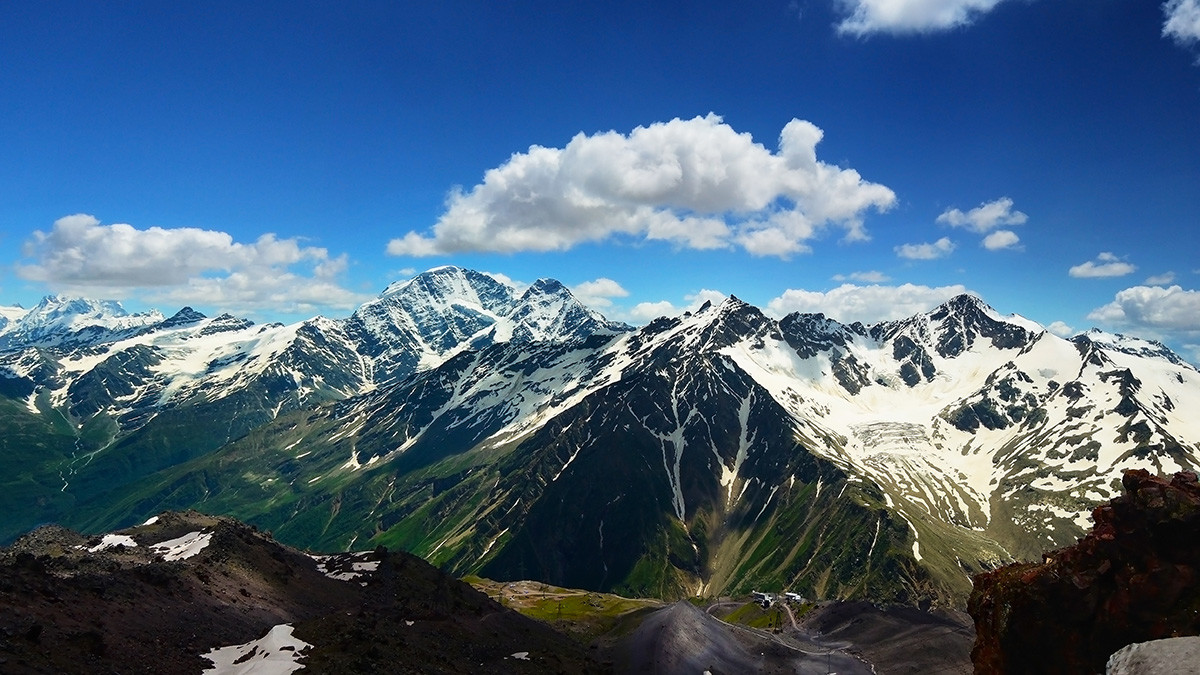
The most famous attraction of the republic – and the Caucasus in general – is Mount Elbrus, the highest peak of the European continent. With a mighty height of 5,642 meters above sea level, Elbrus is actually a dormant volcano. Its permanent icecap feeds 22 glaciers, which, in turn, give rise to the Baksan, Kuban and Malka rivers.
Naturally, if you’re into mountain climbing, this is a peak that you will want to conquer at least once in your lifetime. Here are some detailed accounts of what it entails.
And this is what you’ll see along the way.
Not into mountain climbing? Not to worry! In summer, you can still reach an altitude of 3,658 meters from the bottom of the Azau Valley, thanks to a small network of cable cars and ski lifts. This will give you a bird’s eye view of the entire Main Caucasus Ridge – an extremely impressive sight to behold. And, of course, you’ll be right at the foot of the Elbrus glacier.
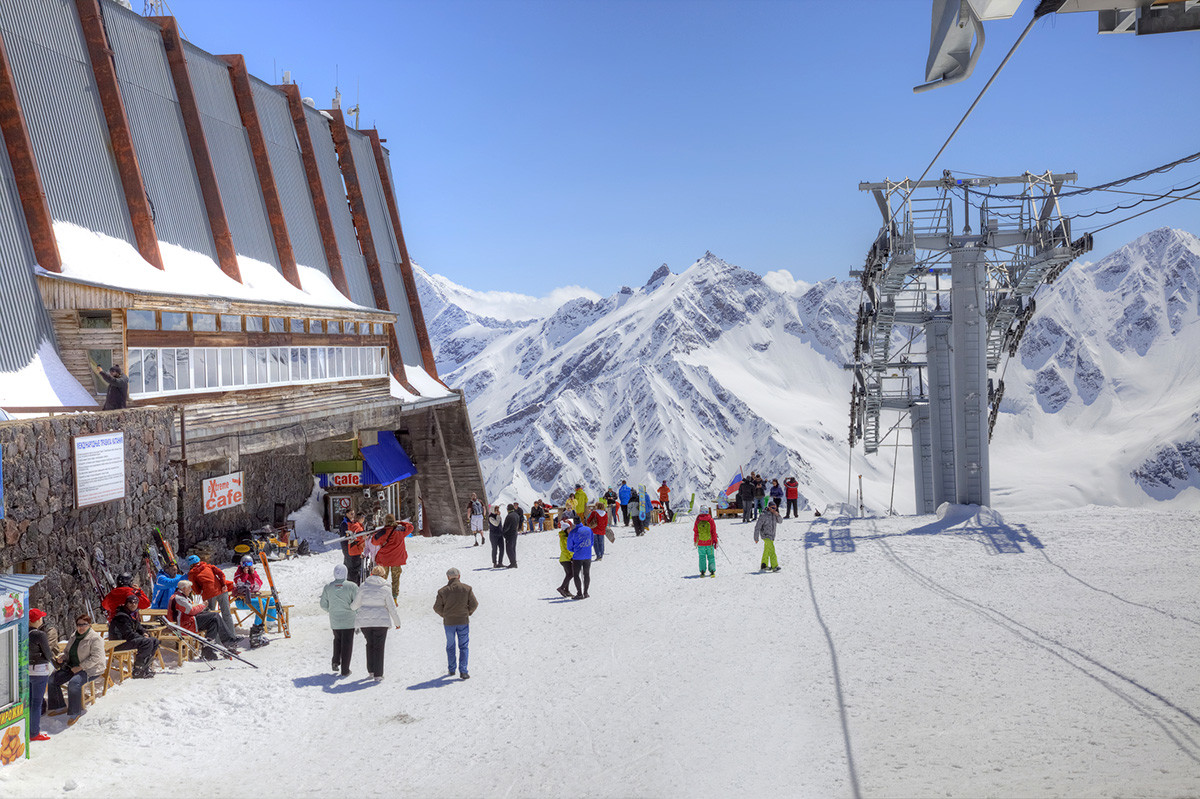
In winter, skiers and snowboarders can shred some sweet gnar on 23 kilometers of slopes serviced by 6 ski lifts. The winter sports area is situated between the elevations of 2,350 and 3,840 meters. There are plenty of accommodation options for a comfortable stay and a good selection of cafes and restaurants to refuel your energy supplies.
2. Dzhily-su
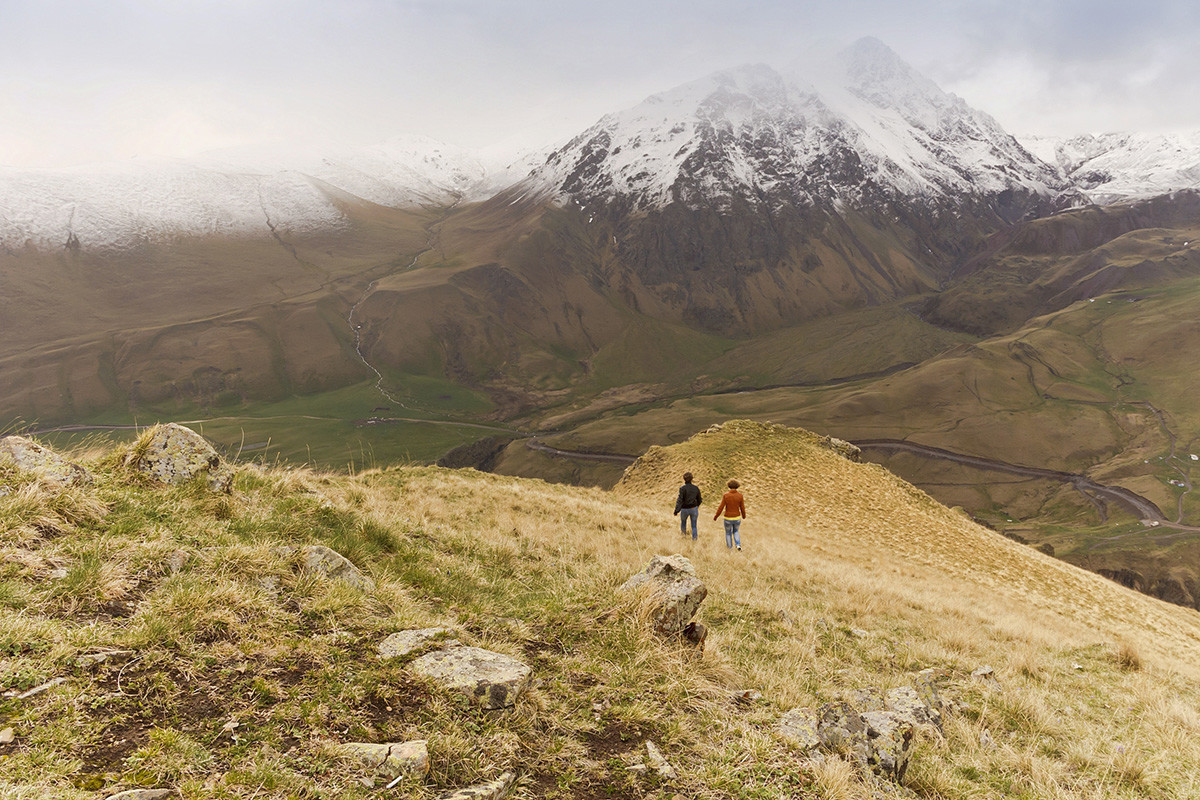
Translated from the local language, “Dzhily-su” means “warm waters”. The Tract is located on the slopes of the heart of the Caucasus at an altitude of about 2,400 meters above sea level, where you can enjoy the breathtaking view of Mount Elbrus on a clear day. On the territory of Dzhily-su, there are many unique mineral springs that aid in healing from various diseases and strengthening the body.
“It’s an amazing sensation when you lie in a warm mineral bath and dozens of small bubbles rise around you. Also, Dzhily-su is the land of waterfalls that bear beautiful male names like Sultan, Emir and Shah. Thanks to the unusual energy, esoterics are particularly fond of this place, because there are natural sand castles, amazing stone mushrooms and the energetic mountains Sirkh and Tuzluk,” Artyem says.
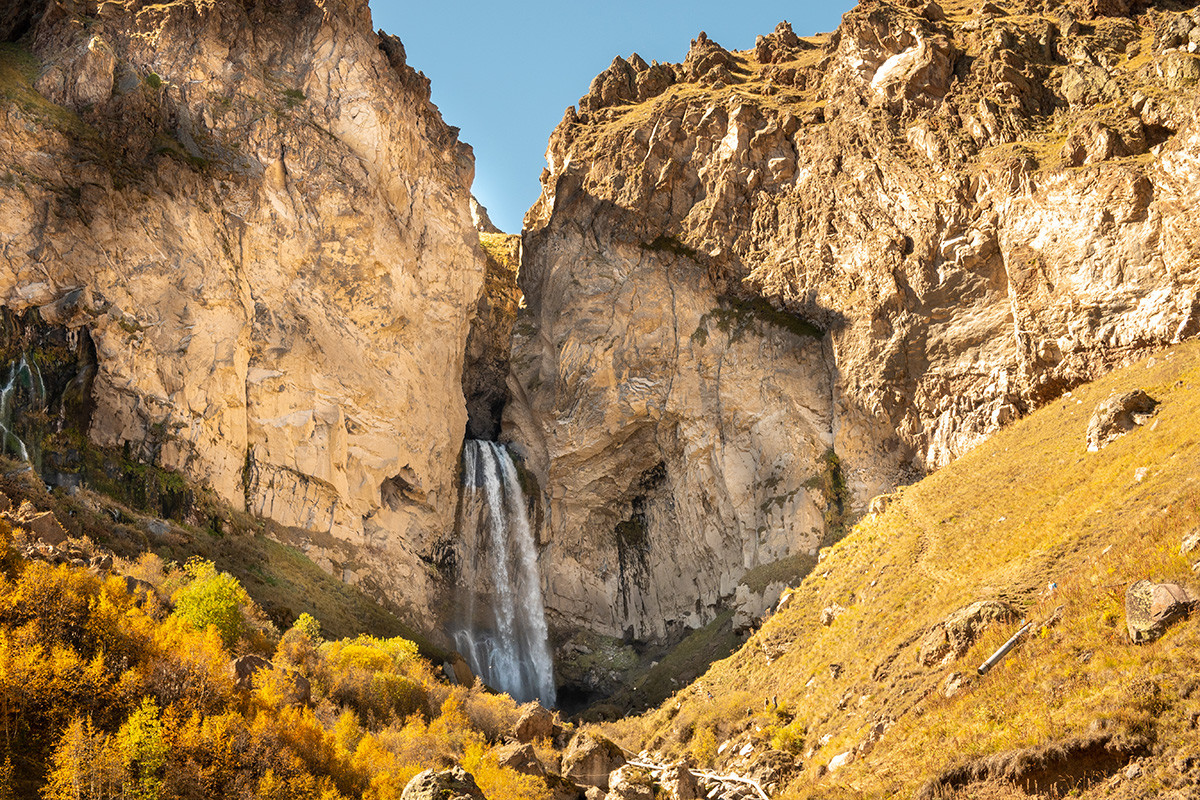
The road to Dzhily-su is considered one of the most beautiful in all of Russia: It’s a serpentine-like asphalt mountain road that follows along a huge cliff, over which you will see many eagles circling. If you decide to do the trip on your own, Artyem warns that you must get hold of an off road vehicle, because many of the roads that you will need to take are dusty gravel roads.
3. Chegem Canyon, Gorge, Waterfalls and Paragliding
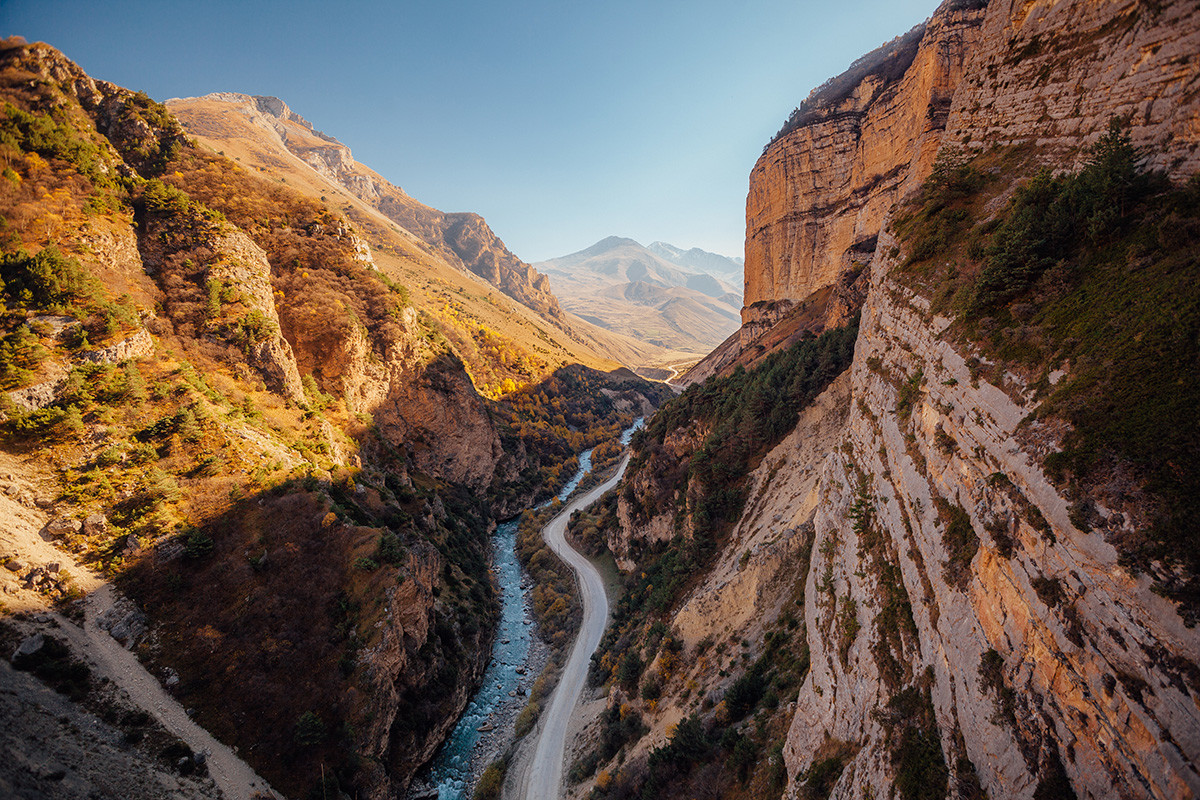
This is one of the main tourist attractions of Kabardino-Balkaria and it’s not hard to see why.
“The views that stretch along the Chegem gorge are simply amazing. The Chegem gorge is quite big. You will begin your encounter with this area with the beautiful Chegem waterfalls that cascade down the rocky slope. Right at the foot of the rocks, there is a small market where local women sell various hand woven wool products. There is a ‘ladder of happiness’ consisting of two 222 steps, leading to the source of the waterfalls at the top of the cliff. Climbing it is not at all difficult, the views are amazing and there is a cozy cafe at the top, as well as at the bottom, where you can enjoy dishes of national cuisine,” Artyem says.
In winter, the Chegem waterfalls freeze and have a certain wild beauty to them. Some locals say that, perhaps, they are even more beautiful than in the summer. Ice pillars and columns of frozen jets and streams of water, like giant twisted candles, or stalactites, hang down all the way to the river.
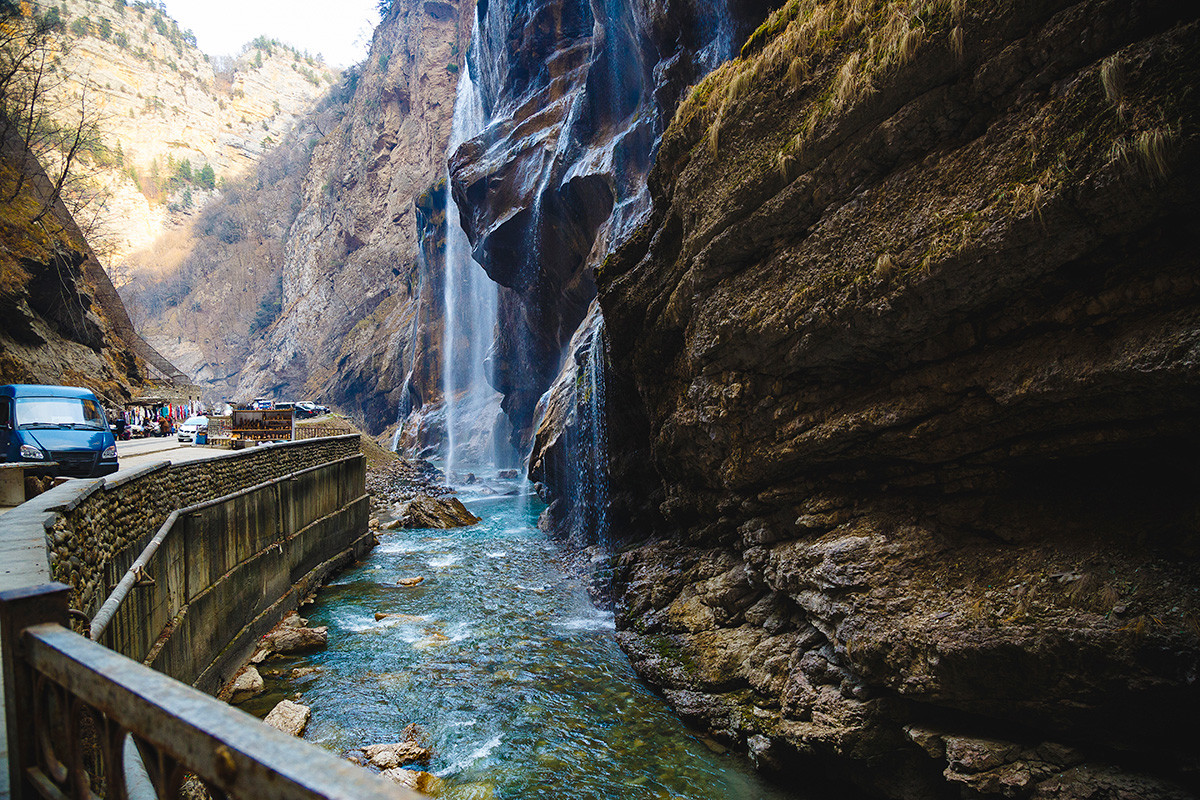
There is no more asphalt road beyond the waterfalls, but you can still continue along the gorge on gravel, along the turbulent Chegem River. The road is very dusty, so Artyem advises visitors to drive along it in a car with closed windows and the air conditioning on. After about 30 kilometers, you will arrive at a paragliding station.
According to Artyem, the Chegem paragliding station is famous for its powerful, ascending wind currents. Thanks to them, paragliders can soar in the sky from morning to evening. On the territory of the station, there is also a zip line and a few other adrenaline-filled activities for those looking for some thrills.
4. El-TyuByu
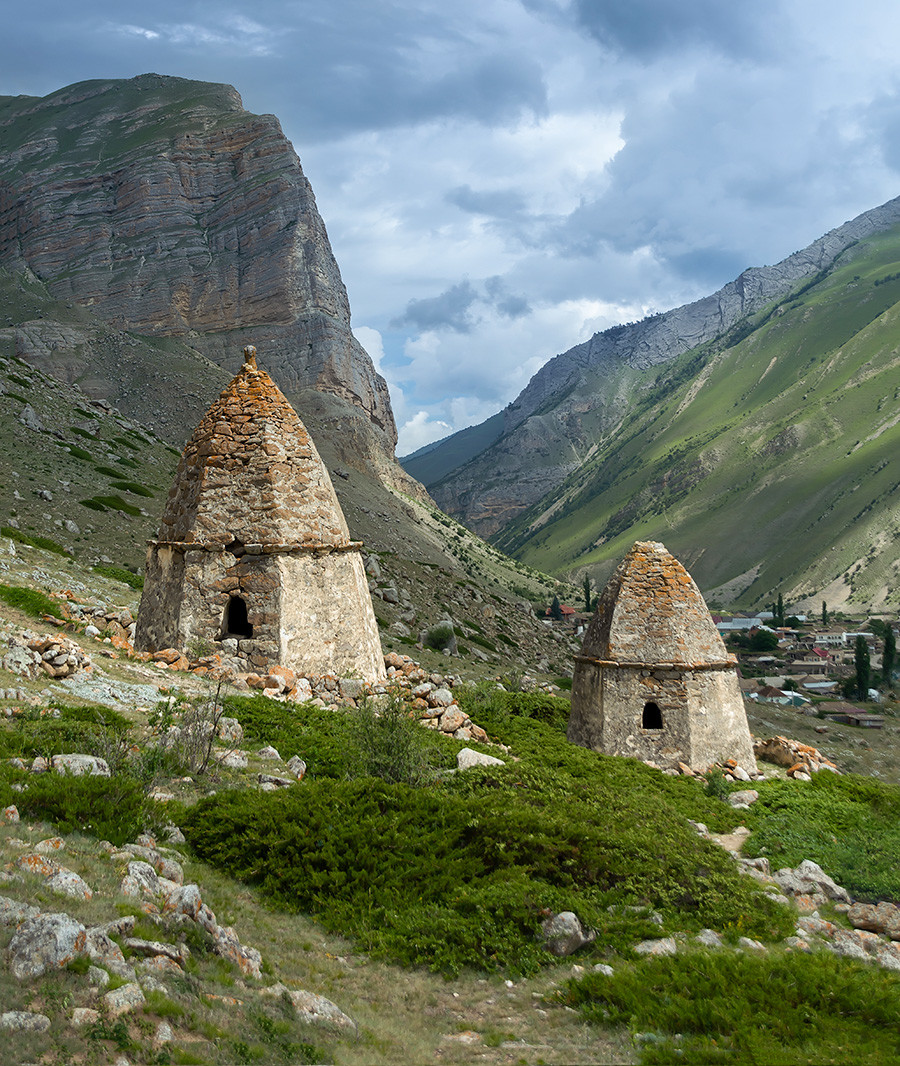
If time permits, you can continue moving along the Chegem gorge and arrive at the village of El-TuByu, a place with enormous history. This mysterious ancient Balkarian village is the focal point of the history of the entire Balkaria. Ancient watchtowers, remains of Greek temples and anomalous phenomena attract both adventure seekers and connoisseurs of beauty. The main highrise, the Balkarukov Tower, is also dubbed the ‘Tower of Love’. Legend has it that Akhtugan Balkarukov built it to defend against the relatives of the beautiful Kerime, stolen by him from Dagestan.
Not far from the village, two ancient defensive Greek stairs go up a rocky wall. They rise to a height of about 30 meters and lead to a small area surrounded by walls up to two meters high and about half a meter thick. A bit above the Greek stairs are the ancient Balkar mausoleums, where local nobility were buried in the VIII-XVIII centuries. Artyem advises to go with a tour guide, because there is just so much incredible history in this village.
5. Valley of the Narzans
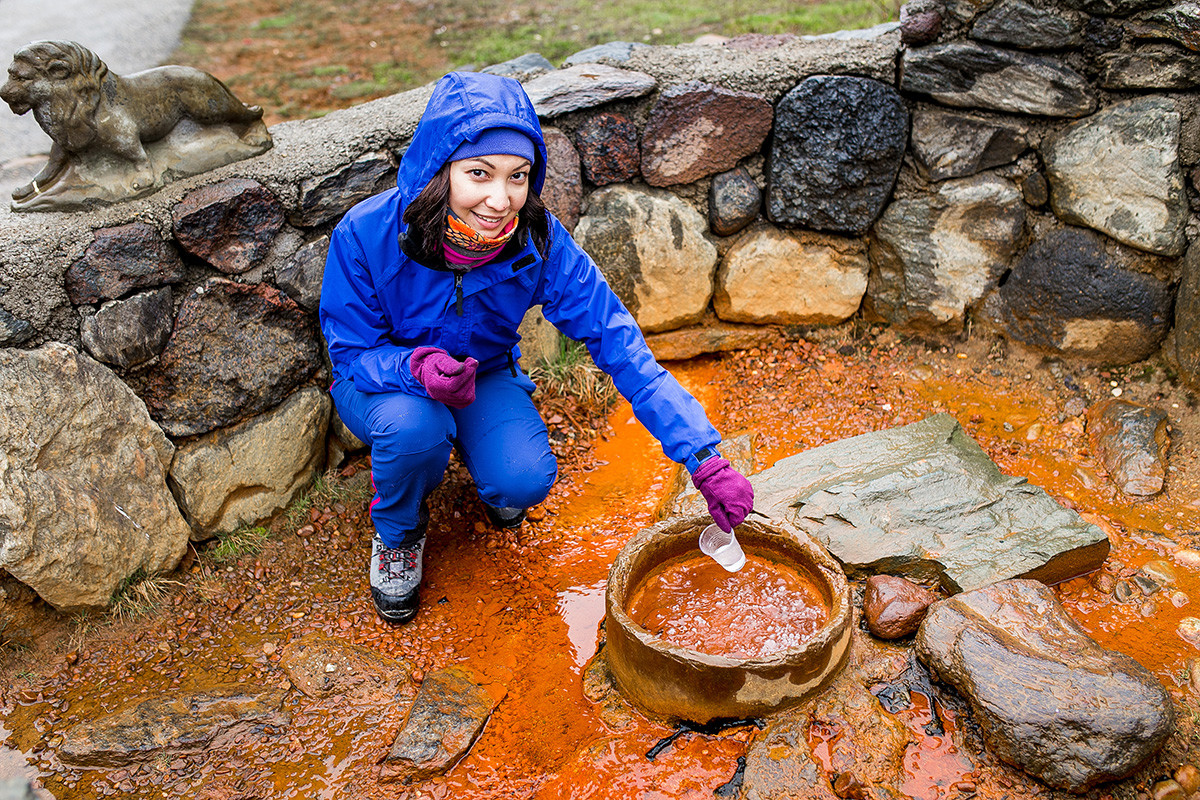
The Valley of the Narzans is a balneoclimatic resort area. It is located in the foothills of the northern slope of the Skalisty Ridge of the Greater Caucasus, in the Khasaut River valley, at an altitude of 1,300 meters above sea level (near the border with Karachay-Cherkessia).
What is Narzan water? It takes six years for the water from the melting snow in the mountains to become Narzan water. It needs this time to find its way through the fissures and cracks in the underground rocks, become enriched by more than 20 minerals and salts, congregate in the underground lakes and then appear on the surface as a spring. In the local language, its name sounds like “Nart-san-e”, which means “a drink of brave warriors”.
Visitors can come with empty bottles and fill them with different kinds of mineral water. The territory of the valley also has cafes with local delicacies and plenty of souvenir stands, where the local women sell traditional knitwear, mountain honey and other arts and crafts and delicacies from the region.
6. Shadkhurei Karst Lakes
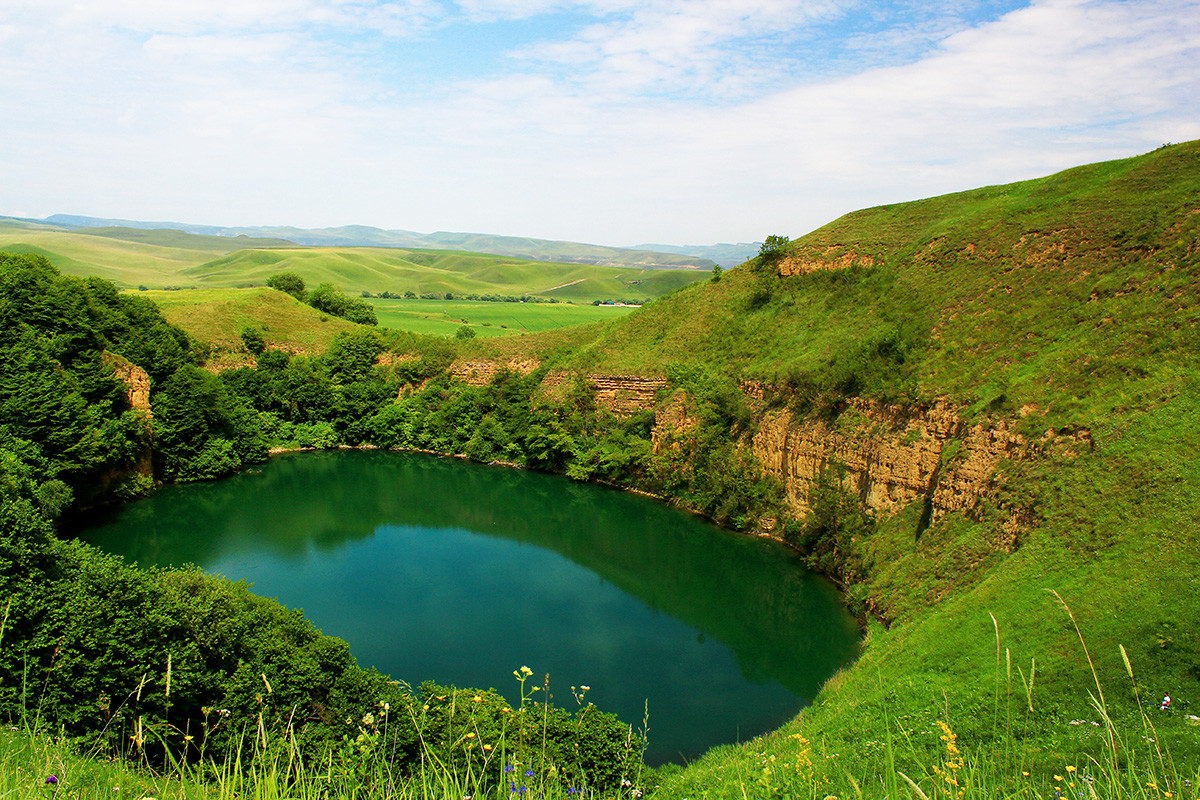
The two lakes - Lower and Upper Shadkhuei - are still little researched. Underwater currents, turmoils and a large network of underwater canals prevent scientists from doing deeper research. The estimated depth of each lake is more than 200 meters, though there is no data yet on the actual depth.
“This is a great place to spend some time, especially during the summer months. The water temperature is kept at the same level all year round – about +15 degrees Celsius. The two lakes are located close to each other and fascinate visitors with their magical colors, luring them into their emerald water,” Artyem says.
In Artyem’s experience, only with rare exceptions, no visitor can resist the urge to plunge into the water. Even without bathing accessories, both ladies and gents make it their priority to jump into the turquoise waters. Around the lakes there are a few gazebos so you can easily stay for the whole day, have a picnic and swim in the lakes to your heart’s content.
7. Chateau Erken
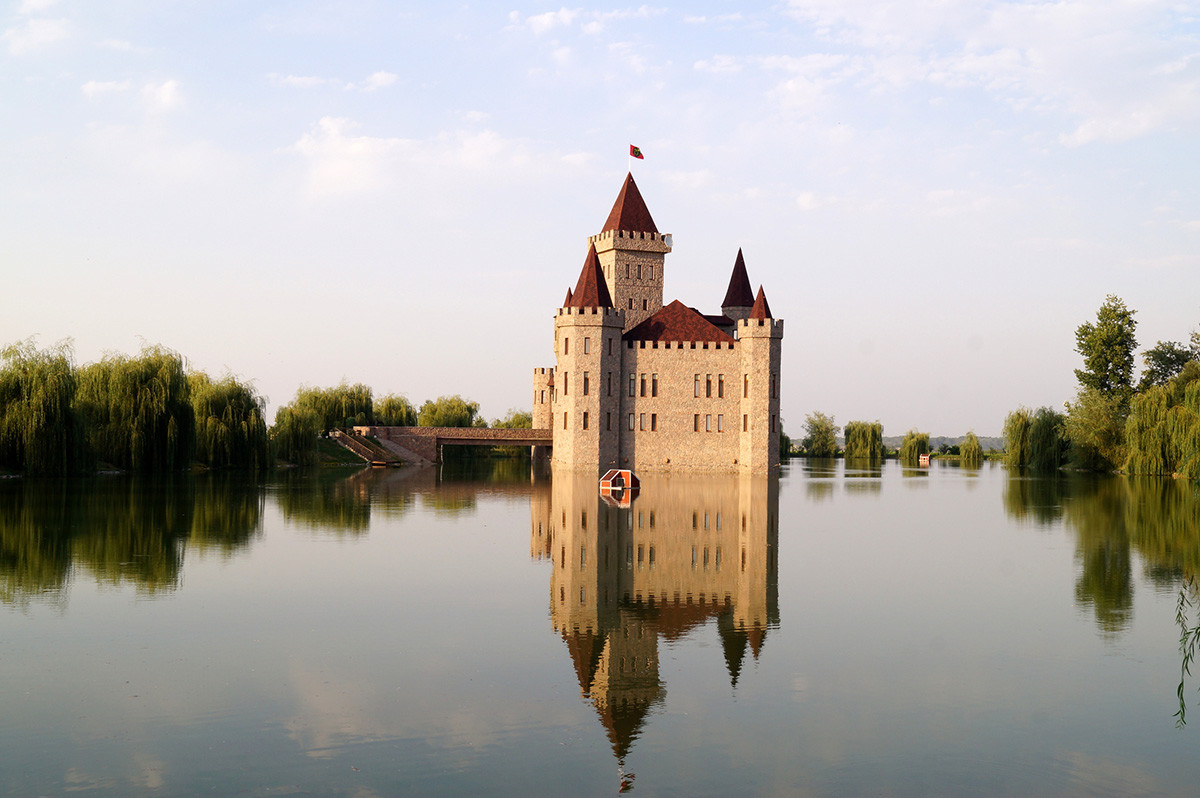
A little piece of Europe in the middle of the Caucasus Mountains, Chateau Erken is a majestic pseudo castle in the Romanesque style (it was actually built in the 1990s) surrounded by about 1,000 hectares of vineyards.
“If you want to have a relaxing day, try experiencing the fairy tale that is Chateau Erken. It stands right on the water and is absolutely stunning. There is also the option to do some wine tasting inside,” Artyem says.
8. Upper Balkaria, Blue Lake and Aushiger Thermal Springs
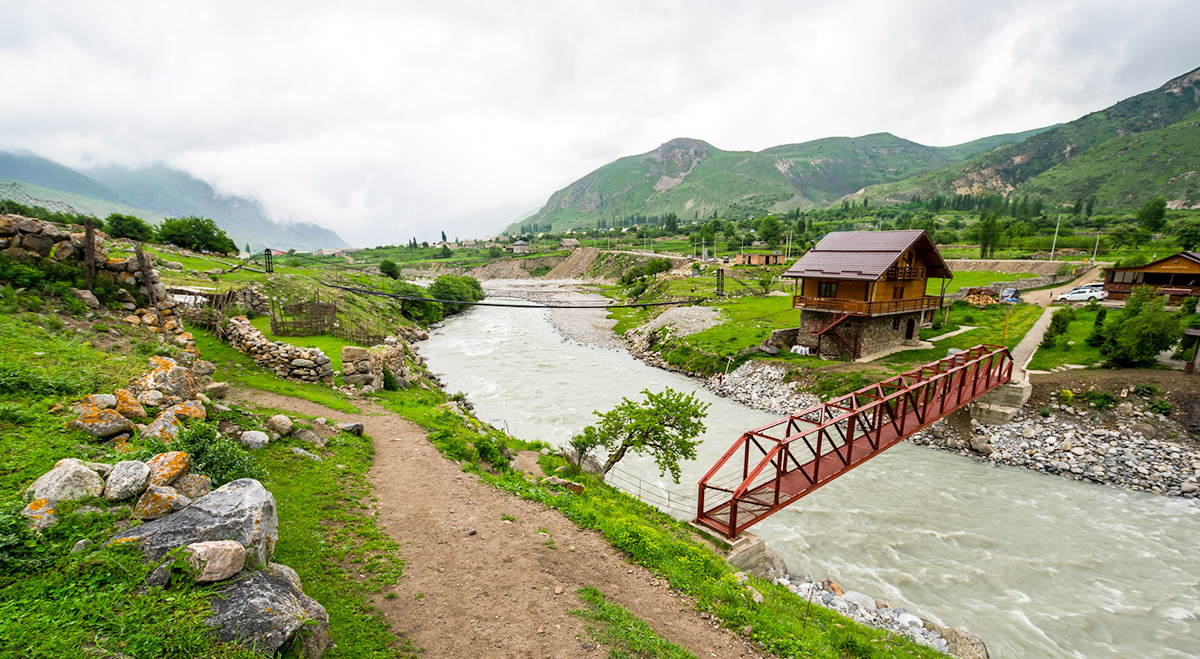
These three places make for an easy day trip, because of their proximity to one another. Start your journey at the Blue Lake . The deep blue waters of this stunning lake, hidden in Russia’s Caucasus mountains, are shrouded in mystery. It’s uninhabited by fish and avoided by locals, but, in recent years, it’s become a popular site for tourists.
After soaking in the lake’s beauty, continue onwards to Upper Balkaria, which is just several kilometers away along the Cherek gorge. This is a small ancient village that almost seems like it’s hiding from the outside world. Architectural monuments, defensive towers, graves and ground crypts have been preserved there. Upper Balkaria serves as an excellent example of Balkarian life and culture. You’ll learn a lot about the ancient auls (Caucasian mountain or desert settlements) and Balkarian settlements from different historical periods.
On the left bank of the Cherek River, in the village of Aushiger, there are a few healing hot springs. The territory of the health resort includes a healing lake, an open reservoir and indoor baths.
9. Adyr-su Gorge
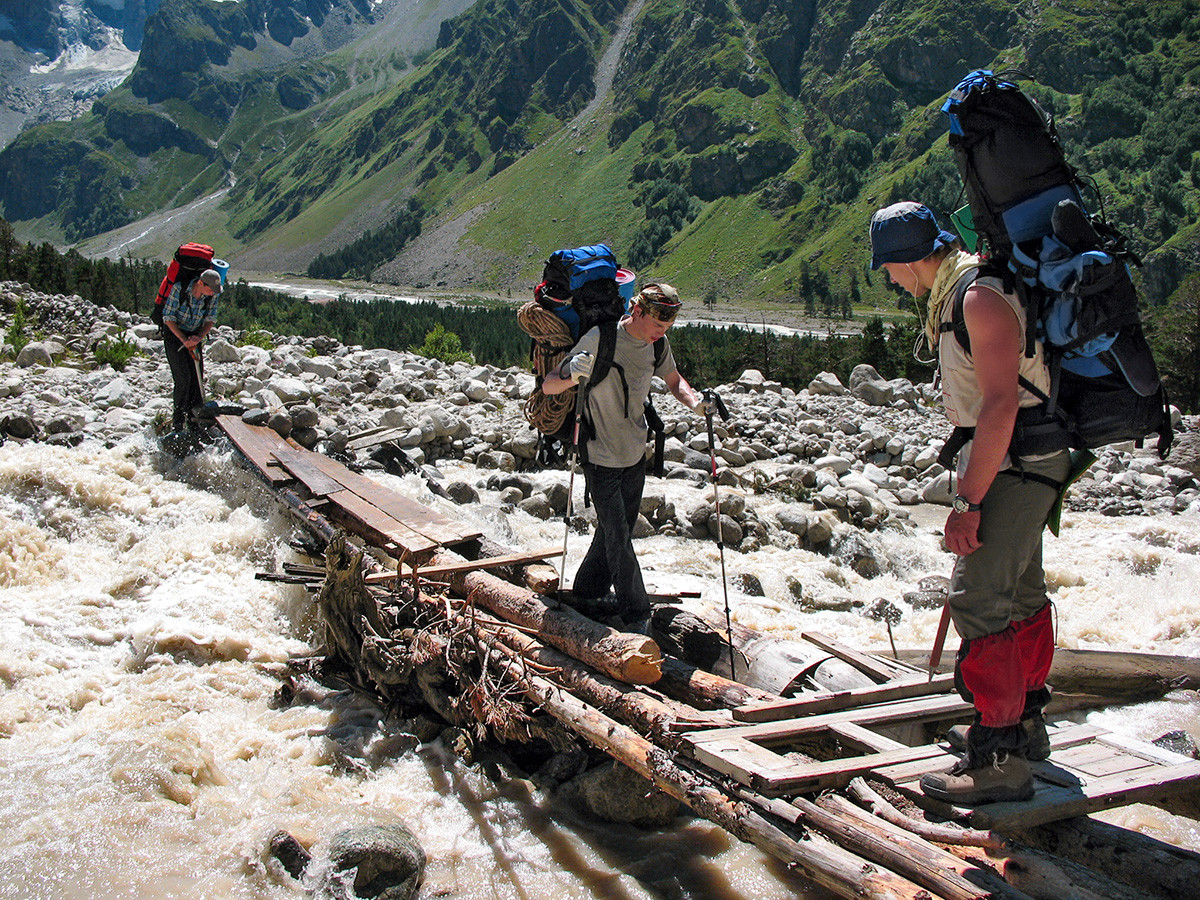
“This place can be reached by car, mostly by asphalt road. Then, the car drives into a special lift, together with people and climbs up along the cliff. What a sight this is! There is a border control here, so it’s a good idea to have some ID on you,” Artyem cautions.
After driving along a relatively easy dirt road, you will get to a mountain climbing base. From there, you can take part in some light trekking, 4 kilometers there and back. Adventurers also have the opportunity to make a wish in the Valley of Desires, see waterfalls, go to the glacier and the huge, magical mountain Ulu Tau, which means “Mother Mountain”. Finish up the hike at the Silver Spring.
“Here, you can always encounter wild mustangs, they always come to graze on the beautiful meadows of lush grass and drink the healing water from the spring. The spring is the source of incredible strength - locals say that whoever plunges into it three times will be healed of many diseases,” Artyem boasts.
If using any of Russia Beyond's content, partly or in full, always provide an active hyperlink to the original material.
to our newsletter!
Get the week's best stories straight to your inbox
- A photographic journey across ALL Russian regions (PHOTOS)
- The Altai Republic: How to get off the beaten track
- 6 BREATHTAKING places in Karachay-Cherkessia you must visit (PHOTOS)
This website uses cookies. Click here to find out more.
- EUR (€)
- GBP (£)
- Contact us

- Currency :
- US Dollar Euro Pound Sterling Russian Ruble Australian Dollar Canadian Dollar Swiss Franc Danish Krone Japanese Yen Norwegian Krone Swedish Krona
- Toll Free 0800 011 2023
- US and Canada United Kingdom Australia Brazil Netherlands Russia Sweden
- Tours by Region Moscow Saint Petersburg Golden Ring Lake Baikal Murmansk Siberia & Far East Sochi & Southern Russia Amsterdam Berlin Copenhagen Gdansk Georgia Helsinki Kaliningrad Kamchatka Karelia Kazan Klaipeda Nizhny Novgorod Northern Europe Oslo Perm Riga Ryazan Stockholm Tallinn Ulan-Ude Veliky Novgorod Vilnius Vladivostok Volgograd Yakutia Yekaterinburg
- Why Choose our Day Tours
- One Day Tours Two Days Tours Three Day Tours
- About Russian tours Private vs Group Tours
- Tours by Region Moscow & St.Peterburg Moscow Saint Petersburg Golden Ring Lake Baikal Trans-Siberian Siberia & Far East Altai Kaliningrad Kamchatka Karelia Kazan Perm Veliky Novgorod Yakutia Yekaterinburg
- Tour Types Small Group Tours Private Tour Theme Tour
- Moscow events St. Petersburg events Events archive
- Events by type Ballet Opera Concert Show All types
- Top theaters Bolshoi theatre - Historic Stage Bolshoi theatre - Small Stage Mariinsky Theater Mariinsky Theatre - Mariinsky II Mikhailovsky Theater
- Direction Moscow - St.Petersburg St. Petersburg - Moscow
- Ships MS Rostropovich MS Volga Dream MS Anton Chekhov MS General Lavrinenkov MS Georgy Chicherin MS Ivan Bunin MS Konstantin Fedin MS Konstantin Korotkov MS Kronshtadt MS Maxim Gorky MS Nikolay Chernyshevsky MS Nizhny Novgorod MS Rachmaninoff MS River Victoria MS Scenic Tsar MS Tikhy Don (MS Alexander Borodin) MS Vasiliy Kandinsky MS Zosima Shashkov Mustai Karim
- Russian Visa Invitation
- Moscow The Kremlin Red Square Golden Ring Tverskaya Street Grand Kremlin Palace (The Kremlin) Christ the Savior Novodevichiy Convent Moscow Subway The Bolshoi Theater Armoury Chamber (The Kremlin) St. Basil's Cathedral The Pushkin Museum of Fine Arts Yury Gagarin Cosmonauts training center
- Saint Petersburg Hermitage Museum Peterhof Catherine's Palace (Tsarskoe Selo) Pavlovsk St. Isaac Cathedral Peter and Paul Fortress Nevsky Prospect Yusupov Palace Savior on Blood Amber room Bronze Horseman (Senate square) Hermitage Theatre Kazansky Cathedral Kronstadt Palace Square Spit of the Vasilievsky Island
- 1/7th of the World Volga River Siberia Baikal Kazan Sochi Smolensk Nizhny Novgorod Kaliningrad Ulyanovsk Verkhoturova Island
- uVisitRussia Why travel with UVisitRussia Customers' Testimonials Contact details Cancellations & Changes
- Russian Travel News
- Russian travel advice Advices while packing Advices while travelling
Kabardino-Balkaria
- Shore excursions
- The Best of Two Capitals Private
- The Best of Two Capitals Small Group
- The Best of Two Capitals Gold
- Russia's Ancient Kingdoms
- Cradle of Russia
- Explore Moscow
- Explore St. Petersburg
- Read Customer Testimonials
- Advantages of Traveling with Us
US office 3422 Old Capitol Trail Suite 1252 , Wilmington DE, 19808 USA. US toll-free: 1-888-845-8877 Russian office Ligovsky pr. 57, Office 19, 191040, St. Petersburg, Russia
tel: +7-812-309-5339
© 2001 – 2024 by Northern Crown, Ltd. uVisitRussia and uVisitRussia.com are registered trademarks . Terms & Conditions Privacy Policy
Sign in with your social account

Sign in to our website using your Facebook or Google+ account.
Why Do You Need Our Travel Expert
Contact our experts, and they will help you to plan your best trip to Russia, with attention to every detail!
Our Experts have been in the travel industry for many years, guarantee to offer first class customer service, excellent value for money and unbiased advice. They are standing by to find and build your dream holiday to one of the world's most fascinating destinations - Russia. Your personal Travel Expert will guide you through each stage of the travel process, from choosing a program that fits you best to support during your trip.
Just tell us your e-mail, and we'll take care of everything!
Ask a Travel Expert
Leave your phone number.
Your tour request has been received. Thank you ! We have sent you the confirmation message to [email]
Please make sure that you receive this message (sometimes e-mail messages may go to the spam/junk mail). If you did not get this message, it means you will not get message with the tours' selection as well. If you use a Yahoo!, Gmail, AOL or Hotmail, we recommend to add [email protected] to your address book.
We recommend to leave your phone number. If we will not heard back that you received the e-mail with the tours' selection, we will contact you by phone. And you will not miss the best tour for you.
Thank you ! Your request for Travel Expert assistance has been sent. We will e-mail you within 1 hour.
Sorry, some changes needed
There was a problem with your request.
Visiting Russia - Nalchik, Capital of Kabardino-Balkaria
By Koryo Tours
Nalchik, capital of Kabardino-Balkaria
Visiting Russia – Nalchik
Yoshkar-ola | cheboksary | astrakhan | elista | stalingrad (volograd) | abakan | nalchik | validkavkaz | makhachkala | grozny.
Nalchik is a small city of around 240,000 people and serves as the capital of Kabardino-Balkaria, one of the lesser-known republics spread across the beautiful North Caucasus area of Russia, the mountain range that separates the former soviet states of Georgia, Armenia, and Azerbaijan from the Russian Federation.
This region has incredible diversity in ethnic groups and is a melting pot at the edge of empire. While there have been civilisations in the Caucasus for millennia Nalchik as a city is only a century old, having been a Russian fort since 1724. Today’s Nalchik is a mostly peaceful and relaxing place, being in the foothills of the mountains it has many areas of great beauty and multiple sanatoria for people looking to take the waters, over the last century it has certainly had its share of turbulence though, being occupied by Romanian troops fighting on the side of the Nazis, who embarked on an effort to exterminate the ancient community of Mountain Jews in the area (unsuccessfully), plus a 2005 Islamic militant attack on Russian security forces.
These days Nalchik is known as a clean city, a place for relaxing, and the starting point of expeditions to summit Mt. Elbrus, the tallest mountain in Europe, which lies within Kabardino-Balkaria.
Kabardians make up the largest ethnic group at just under 50% of the city’s population, followed by Russians, Balkars, other Caucasian nationalities as well as Ukrainians, Mountain Jews still live in the area but in very small numbers now, most having emigrated to Israel.
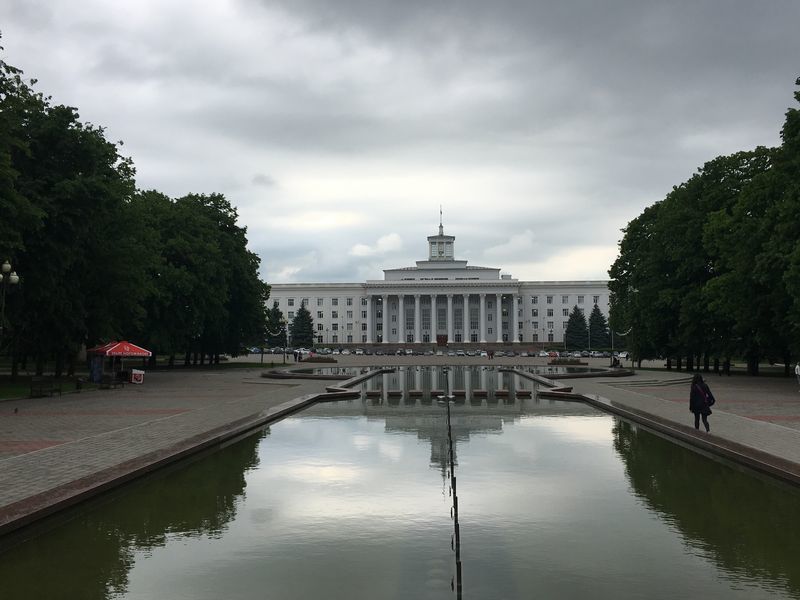
Arriving/Departing
Nalchik Airport (NAL) is a small one but is fully functional for getting in and out, usually the foreigners arriving here will be mountaineers heading for Elbrus.
The Airport is only 3km from the city centre so you could even walk into town from here, otherwise, there are taxis and marshrutkas waiting for arrivals. Flights arrive only from Moscow and St. Petersburg usually, the Caucasus has other larger airports for other international flights (such as those to Sochi). Nalchik has a railway station, dating from 1915, with links to Moscow and across the Caucasus. A good option for travelling around the region in a relaxing manner (usually slower than taking a marshrutka between cities though) For getting around inside Nalchik there are public buses all over the place, easy to use and very cheap. Otherwise most of the centre is very walkable, the main ‘high street’ is Lenin Avenue, which runs for several km through the centre of the city.
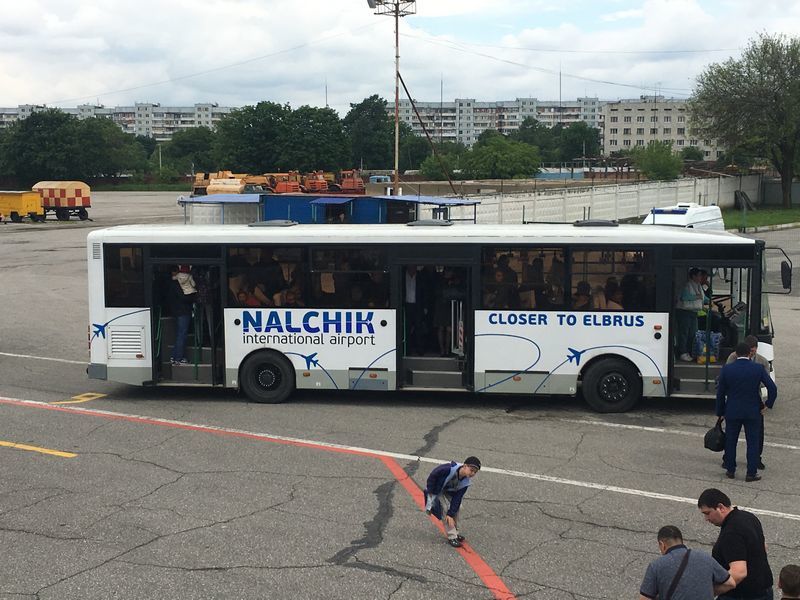
Concord Square
The centre of Nalchik and a good place to start a walking tour of the city, with the Kabardino-Balkaria parliament building on one side and Lenin stands at the other, fountains in the middle and Lenin Avenue cutting through the square
Religious Buildings
The central buildings of the main religions practised in Nalchik are both fine examples of their respective architectural styles; the Central Mosque and the Cathedral of Mary Magdalene are both worth visiting. Dress codes apply.
Not actually in Nalchik, but only 50km or so away so the city is the ideal base for starting an expedition. This is Europe’s highest mountain and a dormant volcano. There are cable car/chairlift options to get t the top for those who don’t wish to do it the hard way. It is possible to get up and down this mountain n a single day, making it certainly the simplest of the 7 continental highest peaks to climb.
Museum of the Kabardino-Balkar Republic
Great for explaining where you are and the history of the area. Mostly in Russian only though and does tend to assume some knowledge in advance. Still a good stop to get some intro into the complex history of this city and area in general.
Atazhukin Garden
A large park complex running for more than 2km along the eastern side of the city, alongside the Nalchik River. A very pleasant place with so much to see and do. The basic Nalchik Zoo is here, walking trails, restaurants and cafes, theatres, a very retro funfair, and a rickety but reliable cable car running up to a lovely viewpoint to see over the city and out to Mt. Elbrus.
Topped by a restaurant building built in the shape of a Kabardian warrior. An excellent few hours can be spent exploring this park and mingling with the locals of all ages who do their relaxing here.

Koryo Tours Russia Tours
Related articles, ulaanbaatar to khovd | a true mongolian roadtrip adventure.
This past summer I set out on a new adventure, travelling from the capital city, Ulaanbaatar, out to the city of Khovd in the far west...
2016 in review: Pyongyang Beer Festival
August 2016 saw Pyongyang hold its first-ever beer festival. Here at Koryo Tours, we were delighted to act as consultants to the Korean organisers, providing advice on how best to arrange such an event.
Museums of Beijing #56: China National Postage Stamp Museum
Stamps, obviously
Museums of Beijing #44: Yunju Temple
Museums of Beijing: Yunju Temple
Is the Pyongyang Metro real? Is the Pyongyang Metro fake? You Decide!
Some frequently asked existential question about Pyongyang’s famous subway system.
Museums of Beijing #101: Pingxi Anti-Japanese War Memorial Hall
Resisting Japan in the west Beijing area
Greg's First Time in the DPRK (North Korea) | Part 1: A Journey Begins
Greg first traveled to North Korea in July 2016 in the footsteps of his grandparents who visited the country in 1988. Since then Greg has become a member of the Koryo family as the head of our Beijing Office and DPRK Tours, and as a Tour Leader.
Museums of Beijing #72: Beijing Taxation Museum
More interesting than it sounds!
Museums of Beijing #46: China Millennium Monument
Sundial Monument, Art Gallery, and more!
Museums of Beijing #33: Beijing Auto Museum
Museums of Beijing: Beijing Auto Museum
Museums of Beijing #25: Guo Shoujing Memorial Hall
Museums of Beijing: Guo Shoujing Memorial Hall
Greg's First Time in the DPRK (North Korea) | Part 3: Kaesong and the DMZ
Driving South to the DMZ, North - South korean border.
Museums of Beijing #4: Beijing Ancient Observatory
Museums of Beijing: Beijing Ancient Observatory
Museums of Beijing #1: Beijing Ancient Coins Museum
Museums of Beijing: Beijing Ancient Coins Museum
Before & After: Changjon Street, Pyongyang
Changes in Changjon Street, Pyongyang, over the years
You have successfully joined our subscriber list.
- Group Tours
- Private Tours
- Pyongyang Marathon
- Turkmenistan
- Cultural Engagement
- Country profile
- Terms & conditions
- Why choose Koryo
[email protected] | + 86 10 6416 7544 WhatsApp (message only): +44 7822 014058 Room A409, Jucai Building. No. 76 Caoyuan Hutong. Dongcheng District, Beijing, 100027, PR China
中国北京市东城区草园胡同76号聚才大厦A 座409 室, 邮编:100027 Download contact card
Not registered yet? Register now
Trouble logging in? Reset password
* All fields are mandatory
Got an account already? Let me log in

IMAGES
VIDEO
COMMENTS
Puerta del Sol, on-campus student housing for rent in Irvine, CA, near University of California, Irvine, are designed to make your college experience a success. We offer extraordinary student apartments with the community amenities and academic environment you need to succeed.
Puerta del Sol. This bustling square located bang in the centre of Madrid is one of the city's most famous sites. With its semi-circular shape, it's a junction for many of the city's historical and busiest streets such as Calle Mayor, Calle del Arenal, Calle de Alcalá and Calle de Preciados, as well as the starting point for all major ...
Puerta del Sol Tours and Tickets. 13,405 reviews. It's fitting that the name Puerta del Sol ("gate of the sun" in English) evokes light and warmth, because this central Madrid square is an energetic hub. A must for first-time visitors to Madrid, the area is packed with hotels, cafés, souvenir-selling vendors, and barhopping locals. ...
Explore the heart of Madrid with our immersive 4K Walking Tour of Puerta del Sol! 🌟 Join us as we take you through one of the city's most iconic and bustli...
Apr 2022 • Couples. Puerta del Sol is mile 0 or center of Madrid, the capital of Spain where there is always street attractions. The horse & Jockey stature is a great point of regency where to meet, in from of the horse, it's back side. It is the "Time Square" of Spain where New-year eve celebration start where the is a tradition of ...
The Puerta del Sol is Madrid's most renowned square. It houses numerous landmarks like "El Oso y el Madroño", KM 0 and the most famous clock in the city. ... Free Walking Tour of Madrid. 9.56 2639 reviews . Free. book. Toledo and Segovia Tour. 9.12 4849 reviews . US$ 76.70. book.
Travel to Puerta del Sol, located in the very heart of Madrid. Many historic sights and popular landmarks on the square are the main Madrid tourist attractions. ... Tour packages with Puerta del Sol, Madrid, Spain . Grid. List. map. 5. 4.93. 122 Reviews. Best of Spain. 5. 4.93. 122 Reviews. Small group tour. 10 days. 1 country, 4 cities. 4-star ...
Madrid Essential: Free Walking City Tour. Uncover Madrid's captivating history, legends, and hidden tales on our 2.5 HRS free walking city tour. Explore the oldest part of the city, witnessing iconic landmarks and discovering the evolution of this vibrant capital. Departing from Puerta del Sol, our passionate guides ensure an engaging journey ...
The Puerta del Sol is an engaging place for evening crowd-watching. (photo: Dominic Bonuccelli) ... From Puerta del Sol, I'm going to do a blitz tour of three major sights. I start by strolling toward the Royal Palace, which I consider Europe's third greatest palace (after Versailles, near Paris, and Schönbrunn in Vienna). Over the years, I've ...
Puerta del Sol, on-campus student housing for rent in Irvine, CA, near University of California, Irvine, are designed to make your college experience a success. We offer extraordinary student apartments with the community amenities and academic environment you need to succeed.
Puerta del Sol, the bustling heart of Madrid, has a rich and fascinating history. Dating back to the 15th century when it was one of the city's gates, this iconic plaza has witnessed numerous important events throughout Spain's history. Puerta del Sol has always been a hub of activity and is now regarded as one of Europe's busiest public ...
1. Puerta Del Sol. We begin our tour at Puerto Del Sol, Madrid's most famous square and what some refer to as the heart of the city. The name Puerta Del Sol (Gate of the Sun) comes from one of the old gates of the city, over which the sun would shine brightly into the square.
Puerta del Sol Tours, Madrid, Spain. The centre of Madrid's New Year celebrations, and mile zero of the city's network of roads. Book your favourite tour online today. Your safety and well-being remains our top priority. ... All road lead to Puerta del Sol. In front of the Post Office, which serves as the office of the President of Madrid, is a ...
some pictures of the puerta del sol apartment for the university of california irvine. this is the shared apartment 2 bed 2 bath floor plan. amenities includ...
Reviewed November 1, 2017 via mobile. If you want to get a real feel for Madrid, download the Rick Steves walking tour podcast (and map) from Apple Podcast and make your way to to Puerta del Sol. It takes about an hour to complete the walk but will give you a much better introduction to Madrid than any open top bus tour.
14 Puerta del Sol Guided tours. 15 Puerta del Sol Summer activities. 16 Puerta del Sol Family-friendly activities. 17 Puerta del Sol Walking tours. 18 Puerta del Sol Good for groups. 19 Puerta del Sol Culinary & nightlife. 20 Puerta del Sol Religious & spiritual activities. Tours in Spain. 1 Barcelona Tours. 2 Madrid Tours.
Madrid Essential: Free Walking City Tour. Uncover Madrid's captivating history, legends, and hidden tales on our 2.5 HRS free walking city tour. Explore the oldest part of the city, witnessing iconic landmarks and discovering the evolution of this vibrant capital. Departing from Puerta del Sol, our passionate guides ensure an engaging journey ...
Arroyo Vista Housing Tours may be scheduled on request. Contact the AV Office at (949) 824-3900 for information. American Campus Communities. Vista del Campo, Vista del Campo Norte, Camino del Sol, Puerta del Sol. Online photo galleries available for each of the American Campus Communities: Vista del Campo Norte, Vista del Campo, Camino del Sol
Zillow has 49 photos of this $749,999 3 beds, 3 baths, 2,615 Square Feet single family home located at 5320 Puerta Del Sol Rd, Camino, CA 95709 built in 2016. MLS #224104434.
Find Property Information for 31699 Via Puerta Del Sol, Bonsall, CA 92003. MLS# OC24200849. View Photos, Pricing, Listing Status & More.
Apply now and experience the rewards of high-quality living. Our apartment amenities and features provide you the perfect combination of comfort and luxury. Start your new lifestyle with a thriving community just moments away. Join our community today and adopt an authentic local lifestyle. Come home to Puerta Del Sol.
B. Car/Public Transport - If you have a car, are using a taxi, or are hitch-hiking your way to Kabardino-Balkaria, the region is accessible by a variety of roads and vehicles. A major Russian federal highway E50 runs through Pyatigorsk into Kabardino-Balkaria, and can take you towards Mt. Elbrus, Nalchik, and deeper into the North Caucasus.
A bit above the Greek stairs are the ancient Balkar mausoleums, where local nobility were buried in the VIII-XVIII centuries. Artyem advises to go with a tour guide, because there is just so much ...
US office 3422 Old Capitol Trail Suite 1252, Wilmington DE, 19808 USA. US toll-free: 1-888-845-8877 Russian office Ligovsky pr. 57, Office 19, 191040, St. Petersburg, Russia
Visiting Russia - Nalchik. Nalchik is a small city of around 240,000 people and serves as the capital of Kabardino-Balkaria, one of the lesser-known republics spread across the beautiful North Caucasus area of Russia, the mountain range that separates the former soviet states of Georgia, Armenia, and Azerbaijan from the Russian Federation.